GoodNotes vs. Notability: which is the note-taking app to rule them all? Find out in our comprehensive comparison! We’ve tested and analyzed every single feature of both apps so you don’t have to buy them to try them. We’ve got a lot to cover, so let’s jump in!
We tested these apps on an iPad 2020 10.2” with 32 GB of storage. App Store prices may vary depending on your location.
Subscribe to our weekly newsletter, The Flow — a concise, value-packed focus and recharge digest for a balanced approach to productivity:
Table of Contents
GoodNotes vs. Notability comparison of:
- Features
- Writing Experience
- Cost & Pricing
- Templates
- Import & Export
- Backups
- Battery Usage & Storage
- User Interface & Experience
- Note-Taking
- GoodNotes vs. Notability for Students
- GoodNotes vs. Notability for Digital Planning
- Closing Thoughts
Feature Comparison
As you read through our GoodNotes vs. Notability features comparison section, please note that we’re comparing the features of the paid versions of the apps. (We’ve broken down the cost comparison in another section.)
Shared features
Both GoodNotes and Notability offer the following features (please note this isn’t a complete list — we’ve just included the highlights!):
- Handwriting to text recognition
- Automatic backups
- Import and export
- Built-in page templates
- Ability to hyperlink pages
- Share documents to web
- Zoom mode
- Built-in stickers
- Favorite colors for pens and highlighters
- Scan documents using your device’s camera
- Templates for different paper sizes
GoodNotes features
Here’s a rundown of the features unique to GoodNotes:
- Notebooks organized as individual documents and folders
- Writing posture configuration
- Pressure sensitivity settings for Apple Pencil and palm rejection
- Laser pointer tool
- Presentation mode
- Open multiple documents simultaneously with tabs
- Hide iPad status bar
- Flashcards using spaced repetition
Notability features
These features are unique to Notability:
- Notebooks organized in Subjects and Dividers
- Add GIFs and web clips to documents
- Publish notes to the Notability template gallery
- Seamless document view
- 2 customizable finger tap gestures
- Access to premium planners, templates, and stickers
- App themes
- Convert handwritten equations to text
- Record audio right in the app
- Password-protect your Subjects, Dividers, and exported PDFs
- Export to Rich Text file or to cloud services
Notability vs. GoodNotes Writing Experience
Winner: GoodNotes
Both apps let you choose between editing and view-only mode. Overall, the writing experience is much smoother and more customizable in GoodNotes. Let’s take a closer look at how the apps compare in terms of Apple Pencil compatibility, pen styles, smoothness, and lag.
Apple Pencil Compatibility
Both GoodNotes and Notability are compatible with Apple Pencil. The writing experience is smoother and more customizable on GoodNotes.
GoodNotes lets you set your sensitivity level and writing posture in the Stylus & Palm Rejection settings:
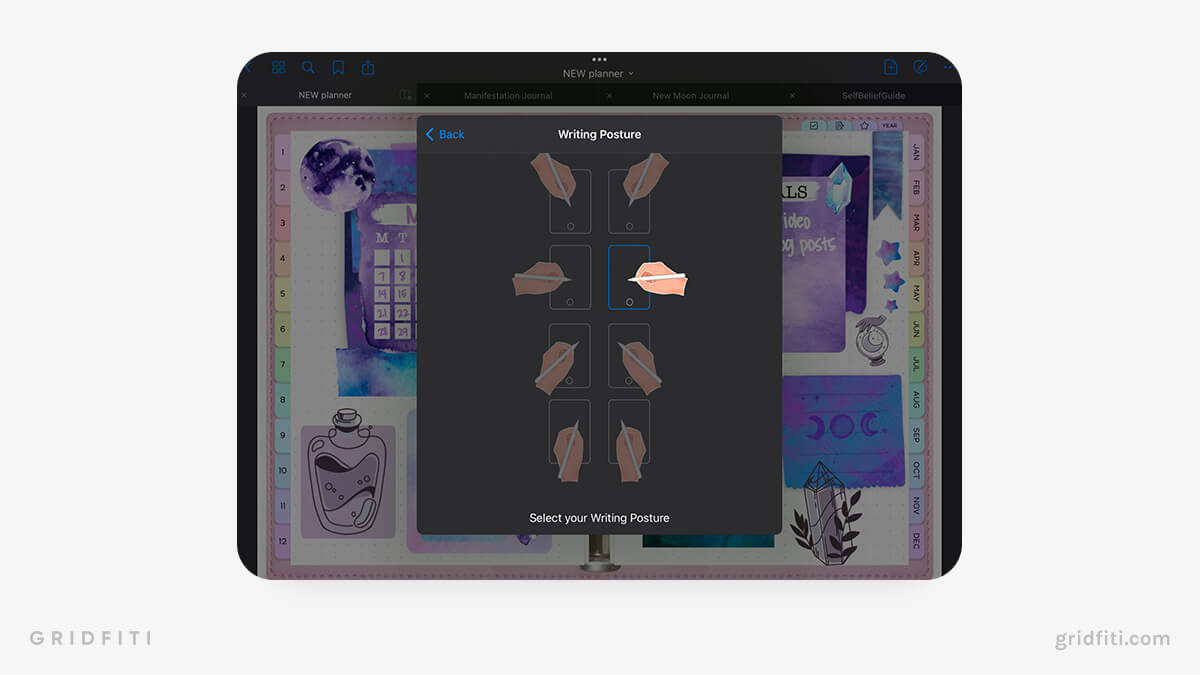 Notability doesn’t currently offer these configuration options. You can toggle on left-handed mode, turn on palm detection, and set up Notability to automatically detect shapes and straight lines.
Notability doesn’t currently offer these configuration options. You can toggle on left-handed mode, turn on palm detection, and set up Notability to automatically detect shapes and straight lines.
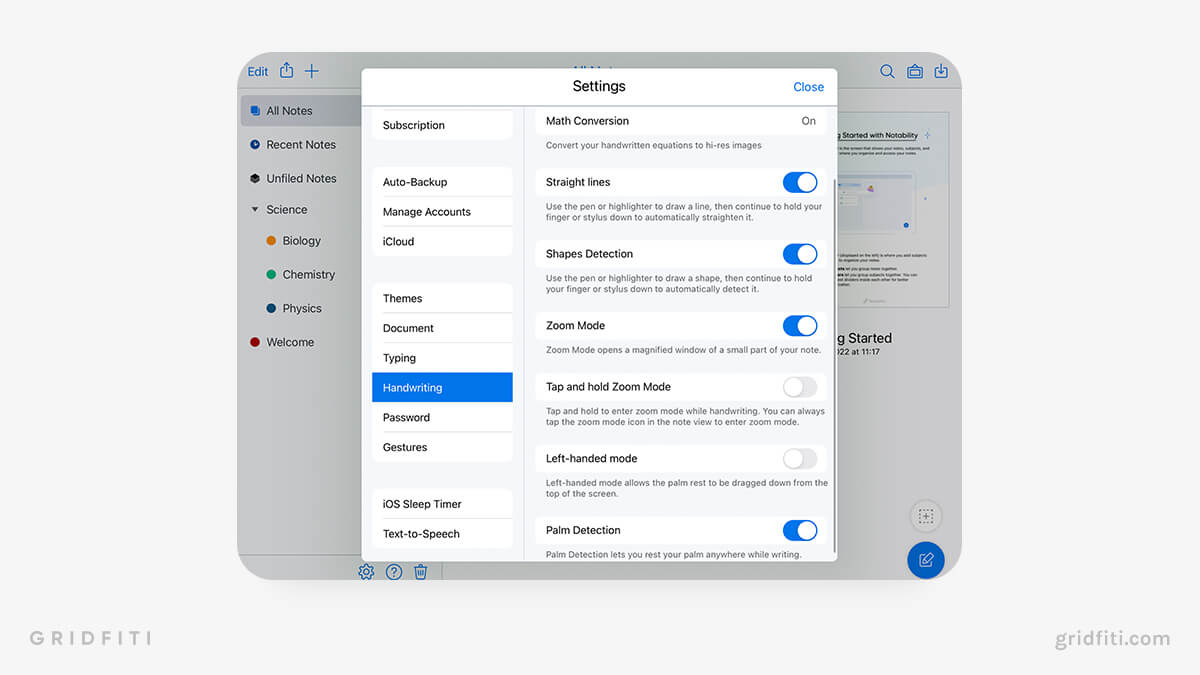
Pen Styles
GoodNotes lets you choose between 3 different pen styles: fountain pen, ball pen, and brush pen.
 The fountain and brush pen modes offer additional customization options for pressure sensitivity and tip sharpness. You can choose between 3 pen thickness modes, each of which can be customized further to your preferred thickness (from 0.1 millimeters up to 2 millimeters).
The fountain and brush pen modes offer additional customization options for pressure sensitivity and tip sharpness. You can choose between 3 pen thickness modes, each of which can be customized further to your preferred thickness (from 0.1 millimeters up to 2 millimeters).
Notability lets you choose between 4 different pen styles: ballpoint, fountain, and 2 dotted lines. Unlike GoodNotes, Notability doesn’t let you choose your own pen thickness — you have to choose from the pre-set options available in the app.
Smoothness & Lag
GoodNotes’ writing posture and sensitivity settings make it easy to create smooth lines with minimal lag:
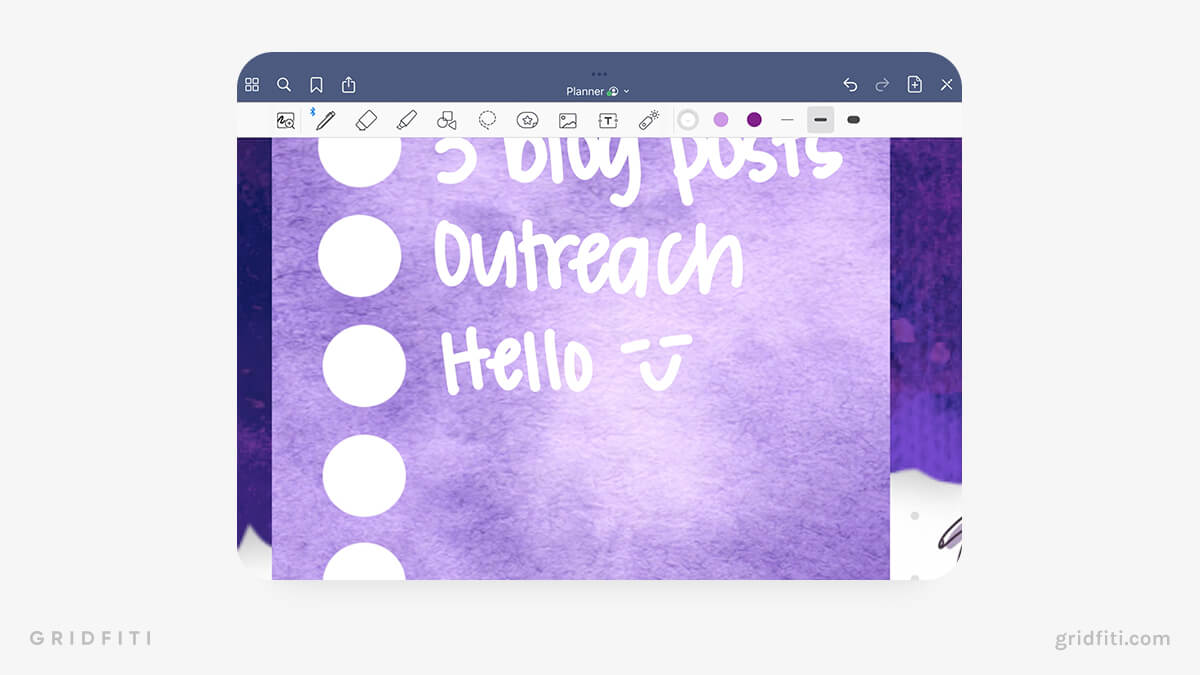 When we tested the Notability’s handwriting quality, we were surprised to find the handwriting appears somewhat pixelated and jagged:
When we tested the Notability’s handwriting quality, we were surprised to find the handwriting appears somewhat pixelated and jagged:
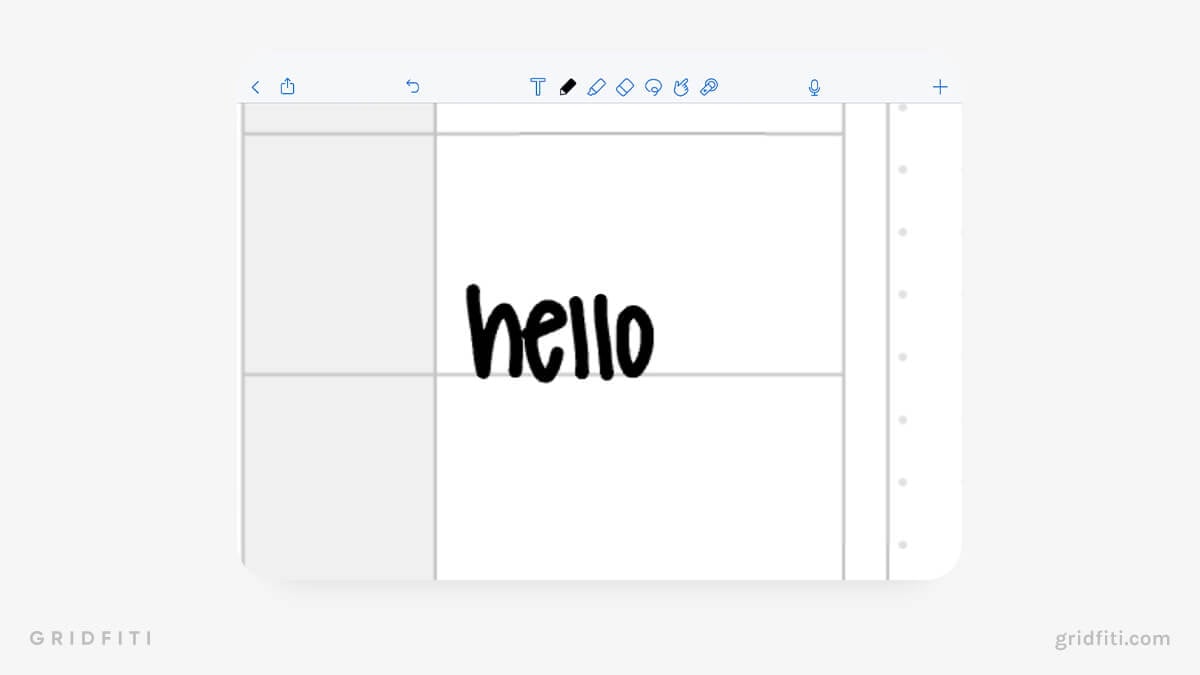 We also had some issues getting the app to pick up pen strokes. On two occasions, we had to write the same word twice because the app didn’t pick it up the first time. Writing quickly with the Apple Pencil also caused Notability to lag slightly for us.
We also had some issues getting the app to pick up pen strokes. On two occasions, we had to write the same word twice because the app didn’t pick it up the first time. Writing quickly with the Apple Pencil also caused Notability to lag slightly for us.
The verdict: GoodNotes has a better writing experience with the Apple Pencil overall compared to Notability.
Cost & Pricing Comparison
Winner: GoodNotes
When it comes to price, GoodNotes is the clear winner over Notability. GoodNotes charges a one-time fee, while Notability charges a monthly or annual subscription. Let’s break it down.
GoodNotes Pricing
How much does GoodNotes cost? As of October 2022, GoodNotes is free on the App Store. Users on the free version can create up to 3 notebooks. Most premium features are also available on the free version. However, some features, like handwriting recognition and email import, are not available on the free version.
The full, premium version of GoodNotes costs a one-time fee of $8.99. You won’t find any other hidden microtransactions or monthly subscription fees.
Previously, GoodNotes was a paid app — users had to pay the subscription fee upfront to download the app. However, that changed in April 2022, when GoodNotes released its new free plan.
Notability Pricing
As of 2022, Notability offers 3 plans: Notability Free, Notability Classic, and Notability Plus. Only certain users have access to Notability Classic. New users can sign up for Notability Plus, which costs $2.99 a month or $11.99 for the first year.
The free plan essentially lets you test-drive the app. You’ll get limited document edits per month — you can see how many edits you have remaining in the settings menu.
The Notability Classic plan is only available to users who bought the app before November 21, 2021, when Notability switched from a one-time fee model to a subscription model — a decision that caused a big stir online. The Classic plan includes unlimited document edits, lifetime access to any premium content purchased before November 2021, and automatic iCloud backup.
Some Notability features are only available on Notability Plus, including:
- Handwriting recognition — Turn your handwriting into text.
- Ruler — Create even layouts and straight lines.
- Favorite notes — Access your favorite notes in one tap.
- Math conversion — Convert handwritten equations to properly formatted text.
- Themes — Add a pop of color to Notability with cute themes.
- Stickers — Embellish your documents with built-in stickers.
- Planners — Choose from 6 beautiful pre-made planner templates.
As we mentioned, the Notability Plus subscription costs $2.99 a month if paid monthly or $11.99 a year if paid annually. However, when we tried to upgrade to a Notability Plus plan from a Classic plan, we did not receive the option to pay monthly. (For this test, our App Store location was in Europe — payment options may vary depending on your location.)
Templates
Winner: Notability
When it comes to in-app page templates, Notability is the clear winner, with more templates and page colors than GoodNotes. However, there is a catch — Notability offers a template gallery as part of its Plus plan:
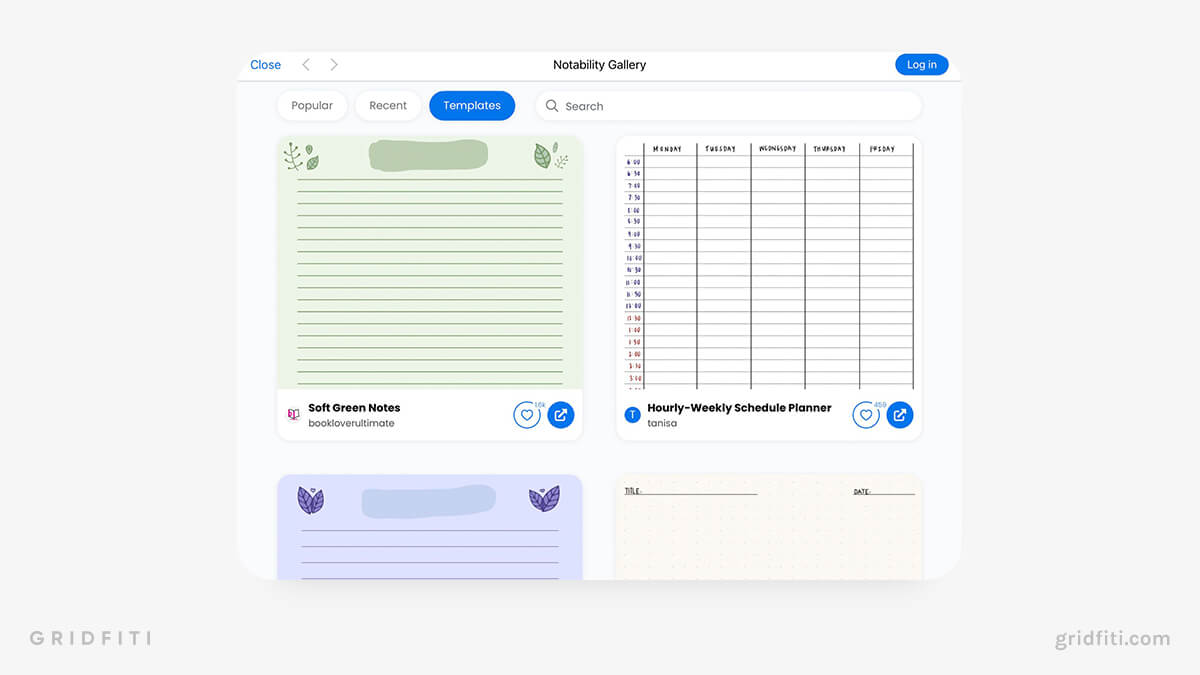 These templates are shared by other Notability users. You can even share your own designs to the gallery as well.
These templates are shared by other Notability users. You can even share your own designs to the gallery as well.
Notability also offers a few planner templates of its own:
 Users on the Free or Classic plans have limited access to these templates. So while Notability technically does offer more templates, users must pay a subscription fee to access all of them.
Users on the Free or Classic plans have limited access to these templates. So while Notability technically does offer more templates, users must pay a subscription fee to access all of them.
Let’s take a closer look at the page templates available in each app.
GoodNotes Page Templates
 GoodNotes offers the following basic page templates:
GoodNotes offers the following basic page templates:
- Blank
- Ruled narrow
- Ruled wide
- Columns
- Dotted
- Grid
- Cornell
- Music staves
- Planning pages
- Flashcards
GoodNotes’ pages templates come in 3 different colors: white, cream, and dark.
You can also import your own page templates, whether you want to use your own designs or purchase a template from an online marketplace like Etsy. Check out our roundup of GoodNotes aesthetic templates to find something new for your digital notebook!
Notability Page Templates
 Notability offers a wide range of page templates. In addition to the basic page templates, Notability’s official templates also include:
Notability offers a wide range of page templates. In addition to the basic page templates, Notability’s official templates also include:
- Sports planners for football, soccer, and basketball
- Recipe template
- Goal tracker
- Meal planner
- Hexagonal grid
- Engineering grid
- Mizige and Tianzege templates
- Coloring pages and worksheets
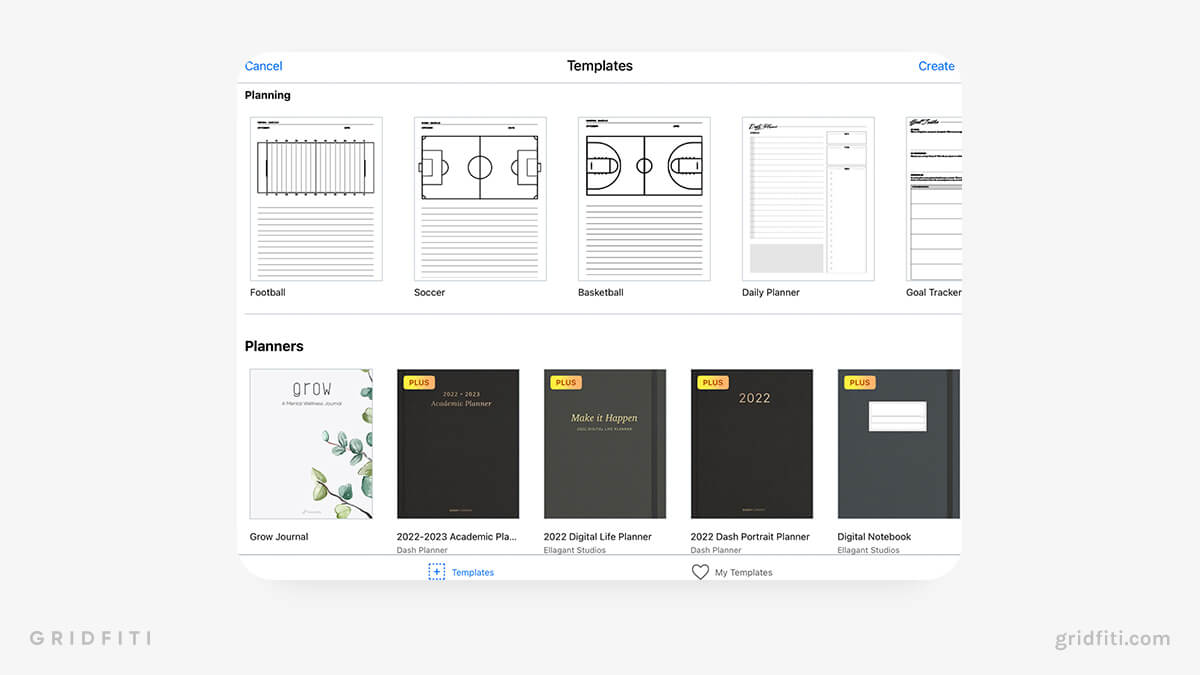 Notability also offers more page colors, including 2 yellows (bright and dark) and a pale blue-gray.
Notability also offers more page colors, including 2 yellows (bright and dark) and a pale blue-gray.
Notability’s template gallery lets users upload their own templates, including stickers, page templates, and even custom fonts. Check out our favorite aesthetic Notability templates to find your next notebook.
Import & Export Comparison
Winner: Notability
When it comes to importing and exporting documents, Notability is the clear winner. Notability lets you export in more file formats and even to cloud services. Additionally, you can export your notes as a password-protected PDF file with Notability. Let’s take a closer look at the import and export processes for each app.
GoodNotes Import
Unlike Notability, GoodNotes only lets you import documents from your locally stored files and iCloud drive. You can also create new GoodNotes files by scanning a document or taking a photo using your device’s camera, or uploading an image from your device’s camera roll.
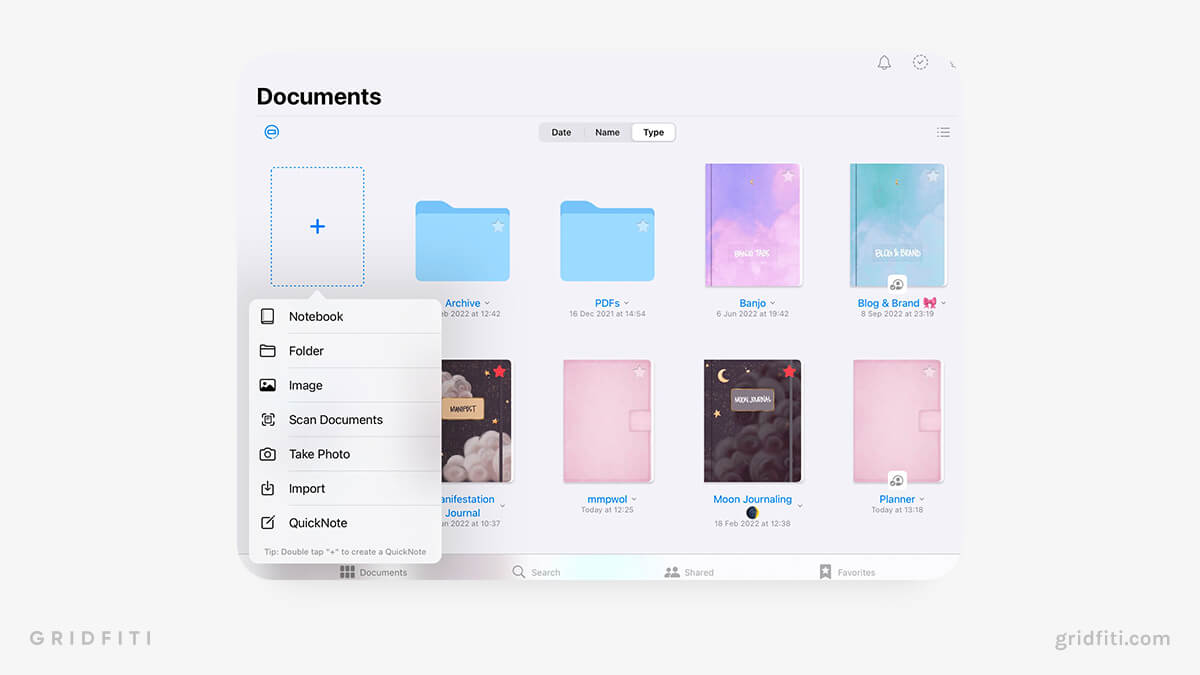
Additionally, you can create a new blank notebook from GoodNotes’ templates, or you can create a new folder to store multiple documents.
Finally, you can import data from GoodNotes 4 if you’re a long-time user. To do this, you’ll need to tap the gear icon in the right-hand corner of the documents view, then select “Import Data from GoodNotes 4”.
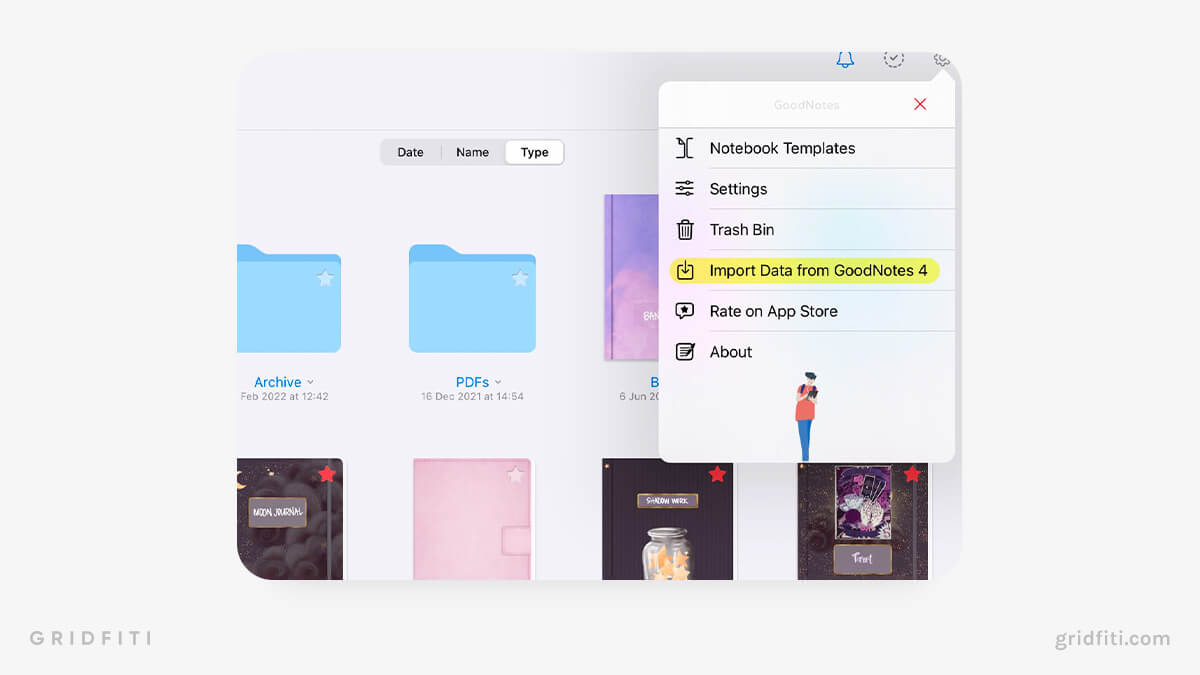 To import a document, tap the blue plus sign located in the top left-hand corner of your documents view. Then, tap “Import”:
To import a document, tap the blue plus sign located in the top left-hand corner of your documents view. Then, tap “Import”:
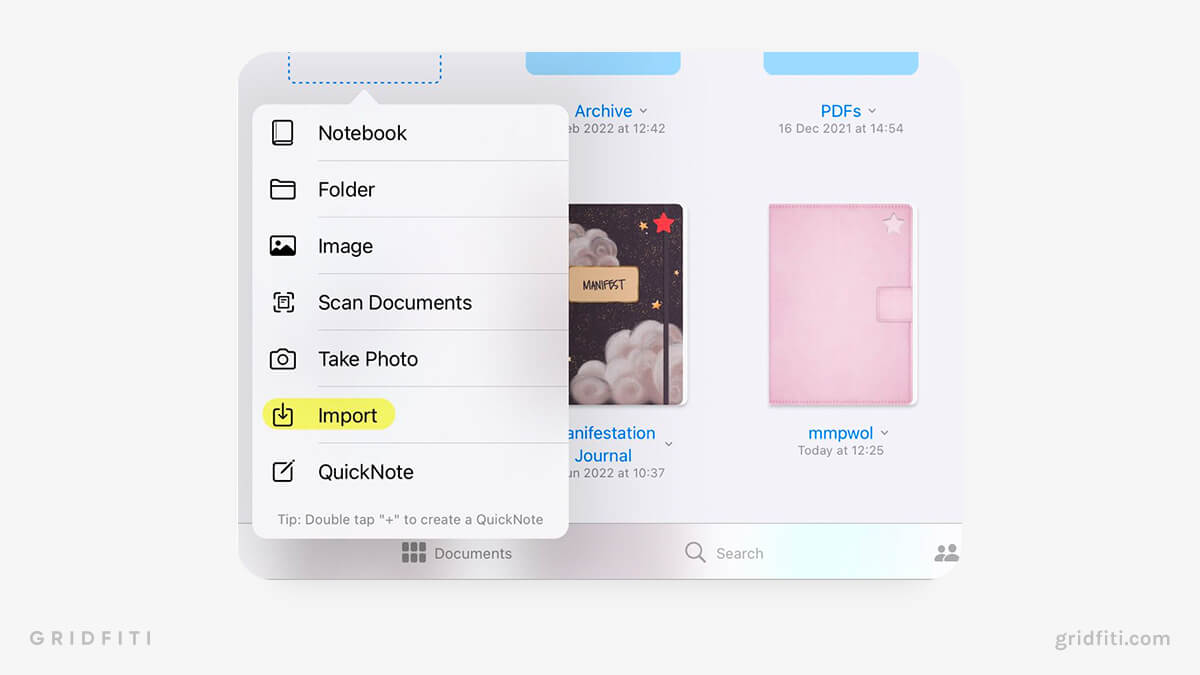 Locate the document you’d like to import in your files or iCloud drive, then simply tap it to upload.
Locate the document you’d like to import in your files or iCloud drive, then simply tap it to upload.
To test import speeds, we imported an 883-page planner. It took GoodNotes about 20 seconds to import the document and another 10 seconds to open it.
GoodNotes Export
GoodNotes lets you export individual pages and full documents in the following formats:
- Image
- GoodNotes file
- Link to a shared web file that lets you (and others, depending on your settings) comment, edit, and share the document
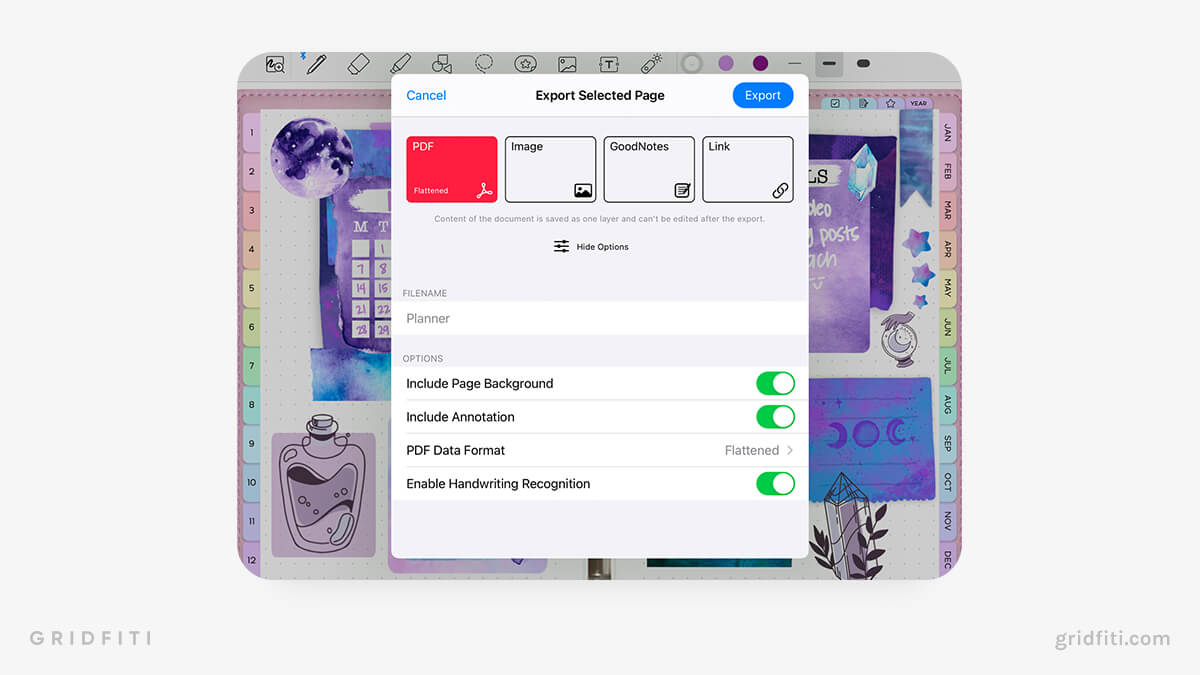 To export a document, tap the “Share” icon in the top left-hand corner of the GoodNotes navigation menu. From here, you can share your document to web, export a single page, or export the whole document.
To export a document, tap the “Share” icon in the top left-hand corner of the GoodNotes navigation menu. From here, you can share your document to web, export a single page, or export the whole document.
Tap one of the “Export” options to choose the file type of your export. Tap “Show options” to access additional settings. These let you decide if you want to display the page background, include annotation, change the PDF format, or enable handwriting recognition.
If you choose to share your document to web, you may need to wait for a moment while the document uploads. After you’ve generated your link, you can update your sharing settings by tapping the “Share” icon again and then tapping “Sharing Settings”. Toggle on “Open Document on the Web” to preview your document on the web:
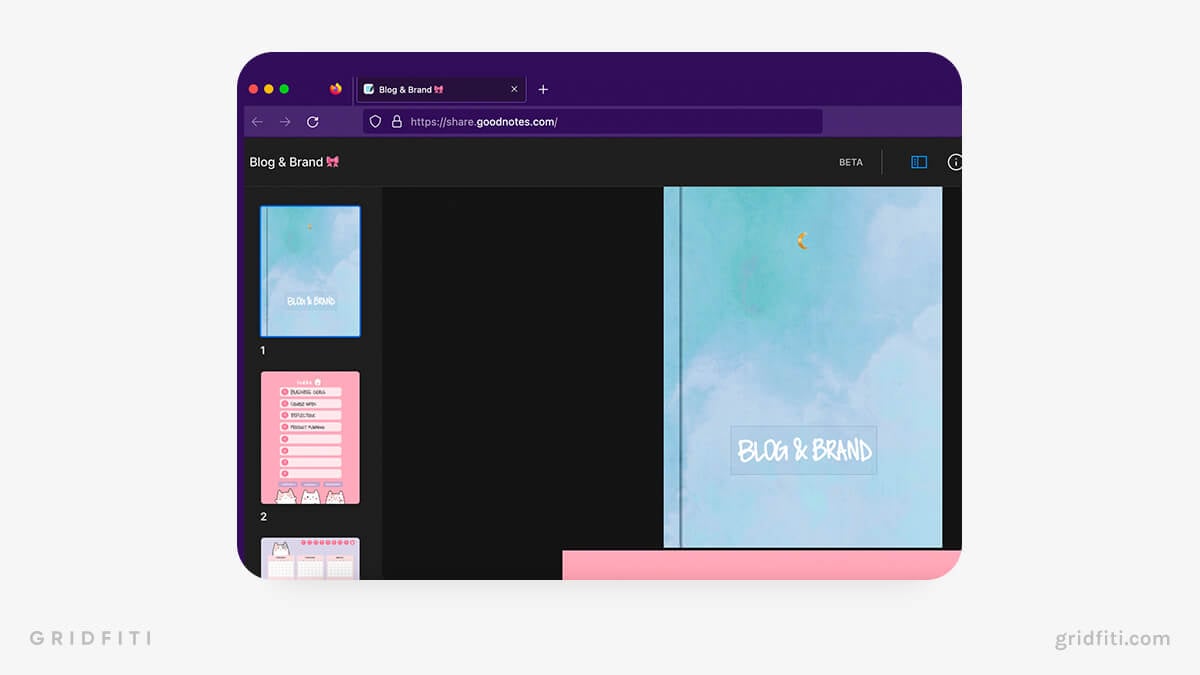 You can view and comment on documents shared to the GoodNotes web editor. Unfortunately, you can’t currently edit documents from the web editor, but GoodNotes says this is a feature that’s coming soon.
You can view and comment on documents shared to the GoodNotes web editor. Unfortunately, you can’t currently edit documents from the web editor, but GoodNotes says this is a feature that’s coming soon.
From the export screen, you can also print your document or enter presentation mode. This mode lets you present your document to someone else. You can choose to share your entire screen (including the GoodNotes interface and device status bar), only the page (without the GoodNotes interface), or the full page (without the GoodNotes interface and Zoom option).
Notability Import
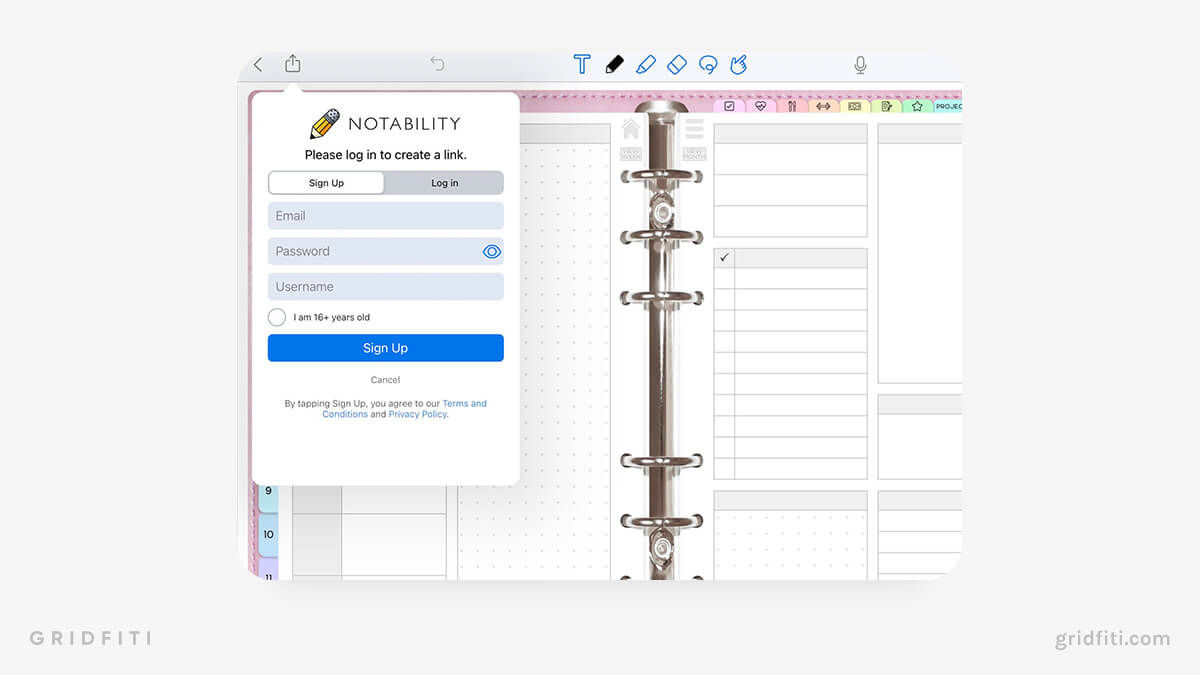
Notability lets you import documents from:
- Locally stored files
- Dropbox
- Google Drive
- OneDrive
- Box
- WebDAV
- Document scan
To test import speeds, we imported an 883-page document. It took less than 30 seconds for Notability to import and open the document — slightly quicker than GoodNotes.
Notability Export
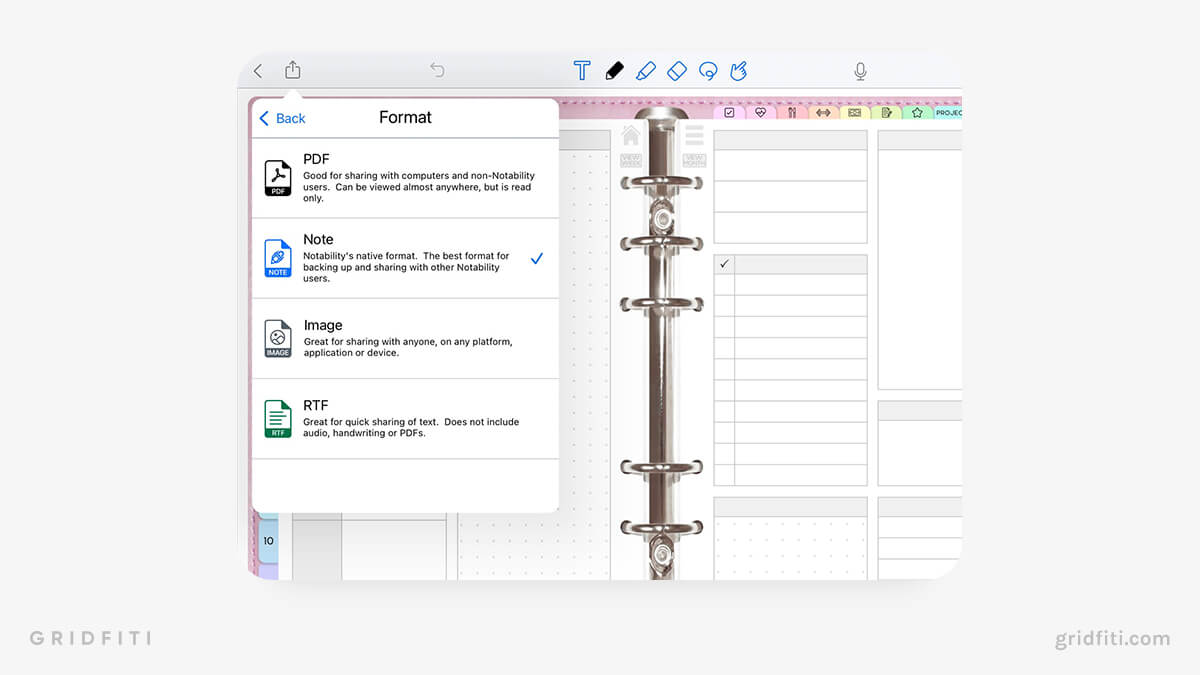 Notability lets you export notes in the following formats:
Notability lets you export notes in the following formats:
- Notability file
- Image
- Rich text
- Link
To create a shareable link to your Notability file, you will need to create a Notability account. This is a separate account from the Apple ID you used to purchase the app.

You can also publish your note to the Notability template gallery. This will make the note available for other users to download and modify. Again, if you want to share your note to the gallery, you’ll need to create a Notability account.
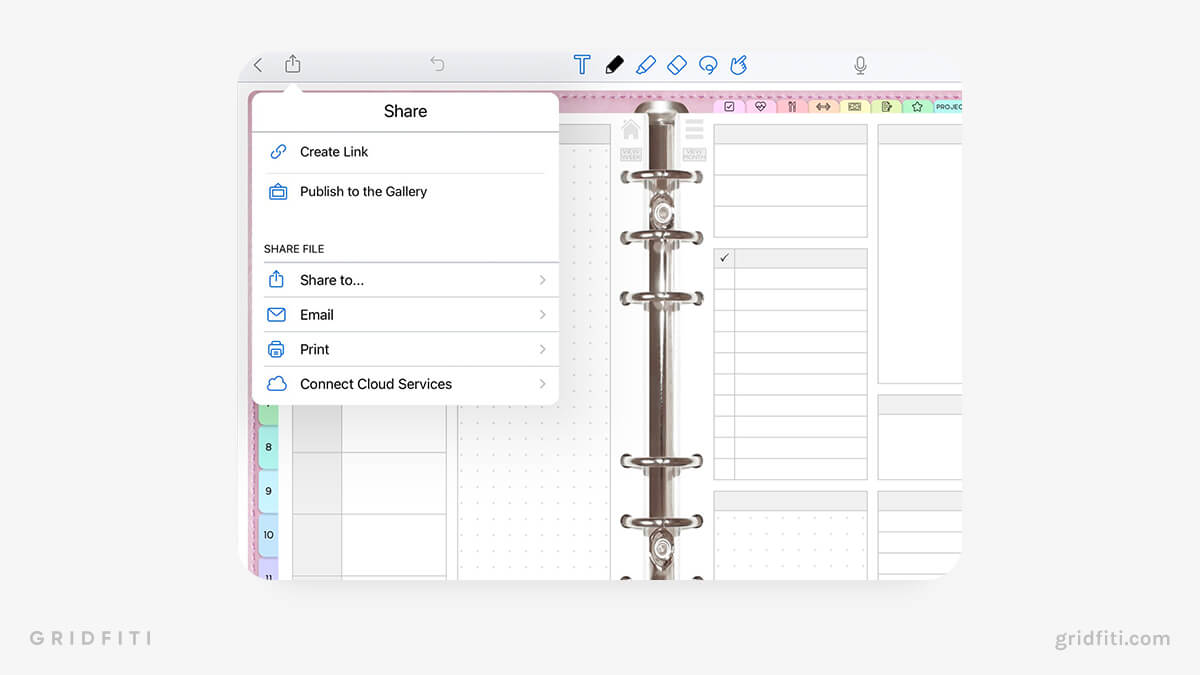
To export a note, tap the “Share” icon in the top left-hand corner of Notability app. If you want to create a shareable link, tap “Create link”.
If you’re simply exporting your note as a PDF, image, Notability file, or Rich Text file, you’ll need to tap “Share to”. Then, tap “Format” to select the format you’d like. Once you’ve chosen your preferred format, you can access additional settings, like password-protecting your file and choosing the pages you’d like to include.
You can also email, print, or share your notes to connected cloud services from this screen. To connect a cloud service, tap “Connect Cloud Services”, then tap the service you’d like to connect. This will take you to the login screen for that service.
Backup Comparison
Winner: Notability
Both GoodNotes and Notability save changes to your files automatically. Notability gets some extra brownie points for backups — it lets you back up your notes to more cloud services and in more file formats. You can also set up automatic backups to your favorite cloud services. Here’s a closer look at how it works in both apps.
GoodNotes Backups
GoodNotes lets you back up files to your iCloud, Dropbox, Google Drive, and OneDrive accounts.
You can configure automatic backups, or you can back up your files manually by tapping the blue gear icon in the top right-hand corner of your GoodNotes home screen, then tapping “Backup Data”, then “Backup Now”.
Here’s how to set up automatic backups to cloud services (excluding iCloud) in GoodNotes:
- From the home screen of your GoodNotes app, tap the blue gear icon in the top right-hand corner.
- Tap “Settings”.
- Tap “Automatic Backup”.
- Toggle on “Auto Backup”.
- Tap “Cloud storage” to choose the platform where you’d like to back up your files.
- Select your preferred cloud services (Dropbox, Google Drive, OneDrive).
- Tap “Sign in to [cloud service]”
- Sign in to your selected cloud service in the pop-up window.
- Tap “Destination Folder” to select the folder where you’d like to upload your backups.
- Tap “File format” to choose the file format you’d like for your backup files. You can choose between PDF, GoodNotes file, and GoodNotes & PDF
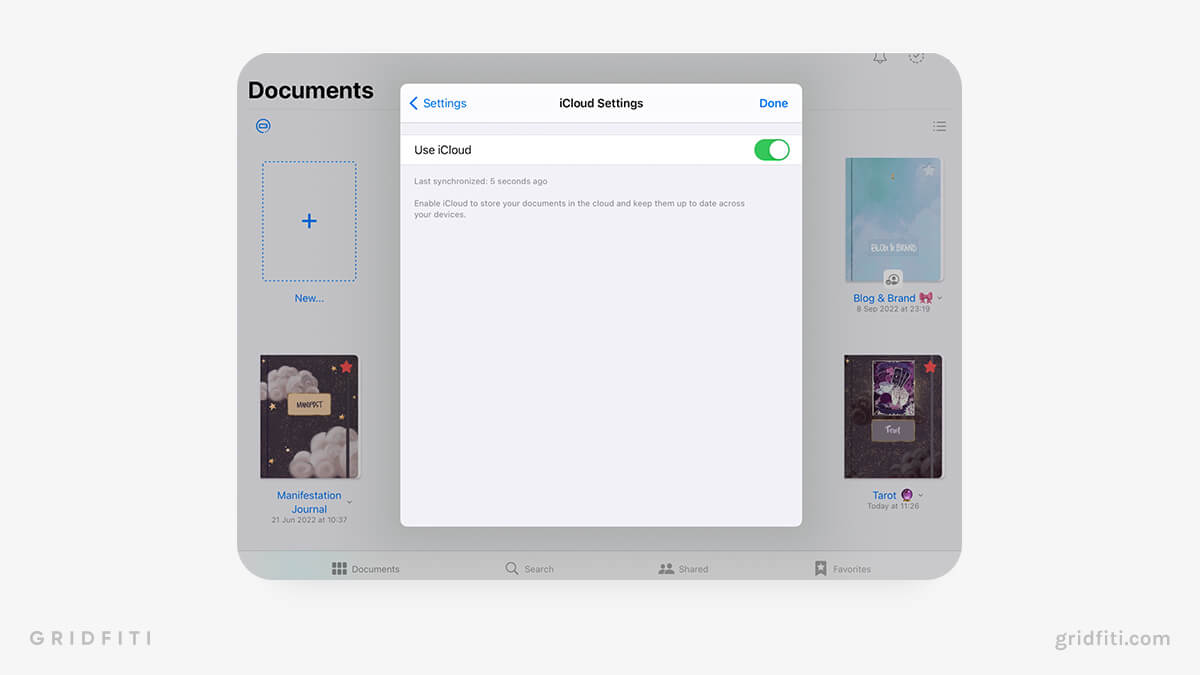 Here’s how to set up iCloud backups in GoodNotes:
Here’s how to set up iCloud backups in GoodNotes:
- From the home screen of your GoodNotes app, tap the blue gear icon in the top right-hand corner.
- Tap “Settings”.
- Tap “iCloud Settings”.
- Toggle on “Use iCloud”.
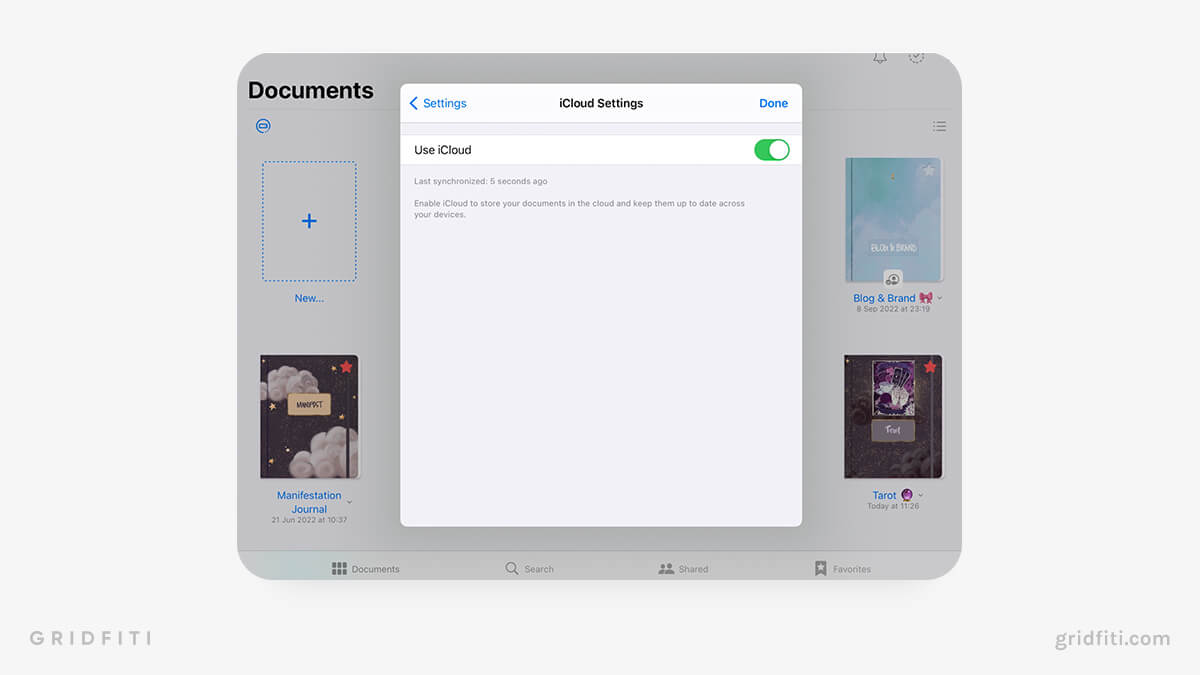
Notability Backups
Notability lets you back up files to Dropbox, Google Drive, OneNote, Box, WebDAV, and iCloud. Like GoodNotes, the iCloud backup settings are located separately from the other cloud services.
Here’s how to back up your files to cloud services (excluding iCloud) in Notability:
- From the home screen of your Notability app, tap the blue gear icon in the bottom left-hand corner, below the Subjects and Dividers.
- Tap “Auto-Backup”.
- Tap the cloud service where you’d like to back up your files.
- Sign in to the cloud service.
- Tap “Destination” to set the folder where you’d like to upload your backup files.
- Tap “Subjects to Back Up” to choose which Subjects you’d like to include in the backup.
- Tap “File Format” to choose the file format for your backups. You can choose between a Notability file, PDF, PDF + Recording, RTF, and RTF + Recording.
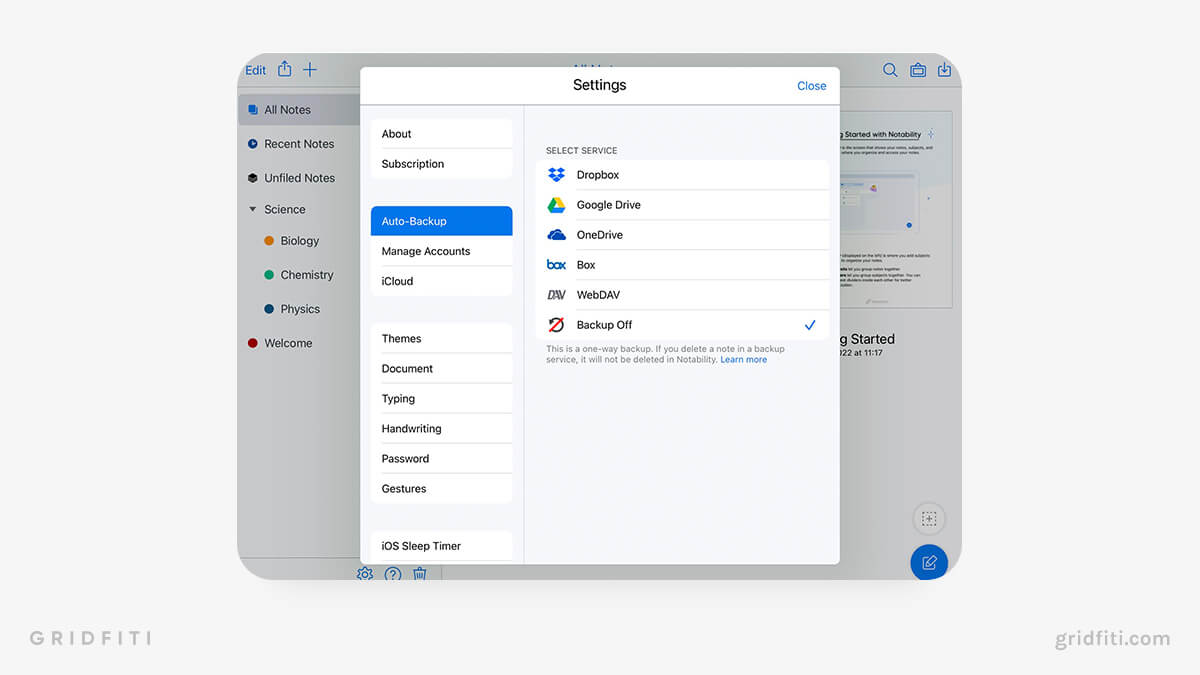 Here’s how to set up iCloud backups with Notability:
Here’s how to set up iCloud backups with Notability:
- From the home screen of your Notability app, tap the blue gear icon in the bottom left-hand corner, below the Subjects and Dividers.
- Tap “iCloud”.
- Toggle on “iCloud syncing”.
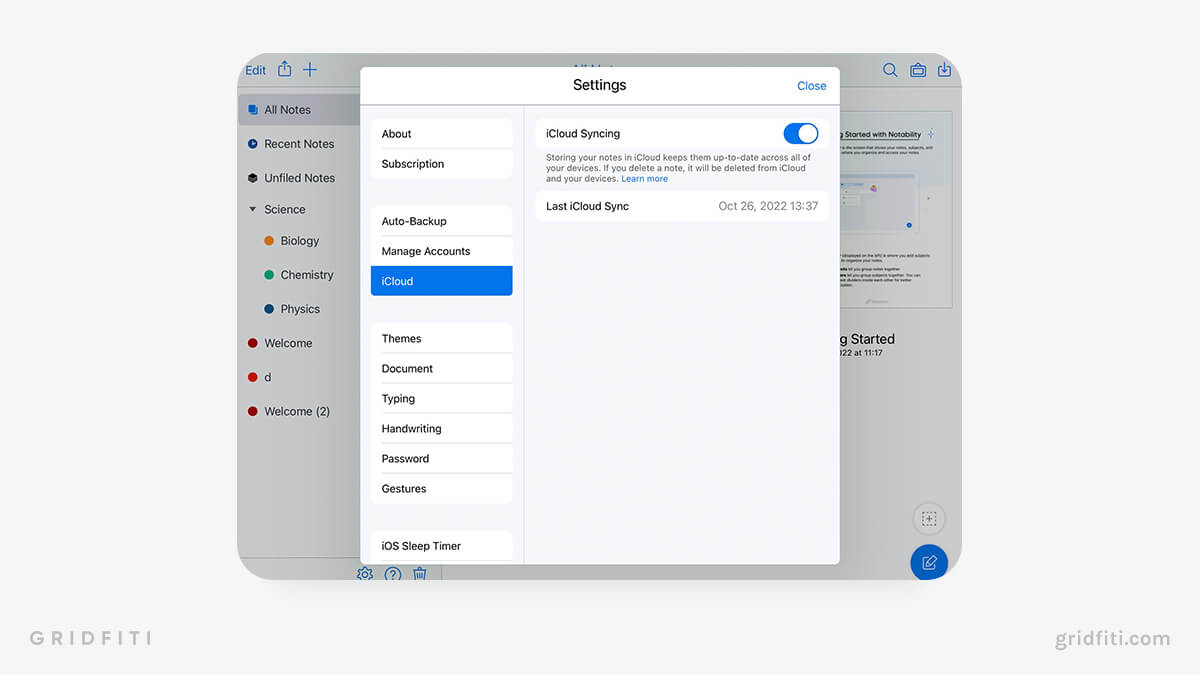
Battery Usage & Storage Comparison
Winner: GoodNotes
When it comes to battery usage and storage, GoodNotes won both our tests. Let’s take a closer look.
Battery Usage
We tested the battery usage of both Notability and GoodNotes on an iPad 2020 10.2”. This is a slightly older model, so battery usage may vary on newer devices.
According to the iPad, here’s how long the apps were open for:
- Notability: 3 hours 48 minutes (2 minutes in the background)
- GoodNotes: 1 hour 38 minutes (14 minutes in the background)
Notability used 80% of the battery, while GoodNotes only used 15%. During this time, we didn’t do a ton of document editing in either app — we were mostly going through each of the settings to write this post. We also imported the same document to both apps.
Storage Comparison
GoodNotes came out on top when we tested the storage of both Notability and GoodNotes on an iPad 2020 10.2” with 32 GB of storage. First, we’ll take a look at the size of each app according to the App Store before comparing it to the actual app size recorded on our iPad.
App sizes according to the App Store:
- Notability: 1.4 GB
- GoodNotes: 522.5 MB
App sizes according to our iPad’s storage settings:
- Notability total storage: 2.7 GB
- GoodNotes total storage: 2.33 GB
Notability took up slightly more storage space than GoodNotes on our iPad. However, we have 25 documents stored in GoodNotes and only 2 notes in Notability. Both documents in Notability contain 600+ pages, while our GoodNotes documents vary in size, with our smallest document containing only one page and our largest document containing 976 pages.
User Interface & Experience
GoodNotes User Interface
When you open the GoodNotes app, you’ll land on the Documents screen. This shows all your documents and folders in list or thumbnail view.
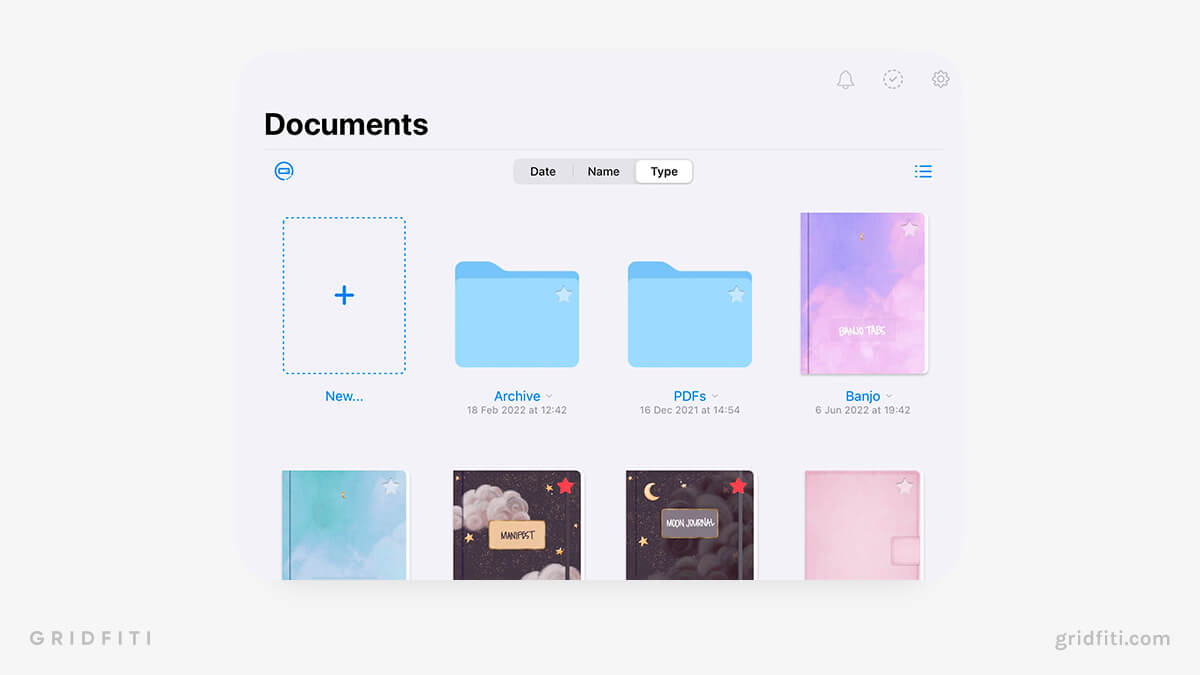 The menu with 3 icons in the top right-hand corner is where you’ll find your settings, notifications, and the option to select documents for export, duplication, relocation, or deletion. Tap the gray gear icon to access your app-wide settings, trash bin, and notebook templates.
The menu with 3 icons in the top right-hand corner is where you’ll find your settings, notifications, and the option to select documents for export, duplication, relocation, or deletion. Tap the gray gear icon to access your app-wide settings, trash bin, and notebook templates.
The blue hard drive icon on the left-hand side of the app lets you manage your automatic backups. Tap this icon to pause or see the status of your automatic backups.
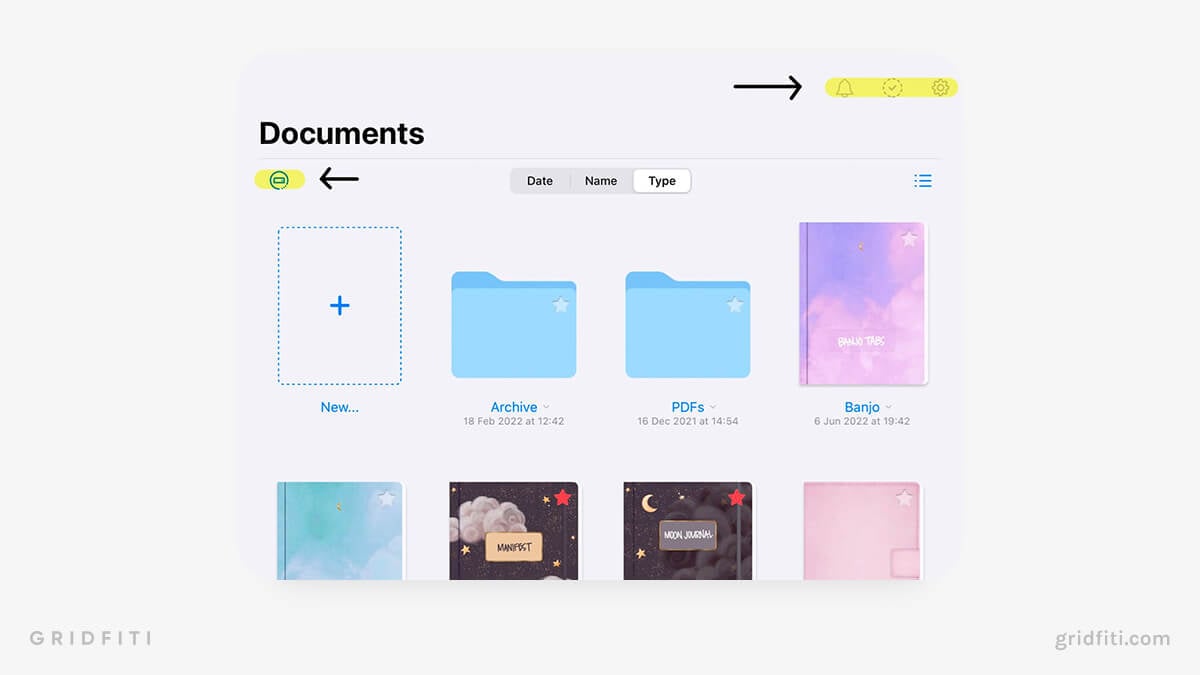 The gray menu in the middle lets you sort your documents by Date, Name, or Type. Just to the right of these options, you’ll see another white icon — tap this to switch between thumbnail and list view.
The gray menu in the middle lets you sort your documents by Date, Name, or Type. Just to the right of these options, you’ll see another white icon — tap this to switch between thumbnail and list view.
The bottom navigation ribbon includes 3 items in addition to the Documents view: Search, Shared, and Favorites. From here, you can search for a document, view documents you’ve shared or that have been shared with you, and access your Favorited notebooks.
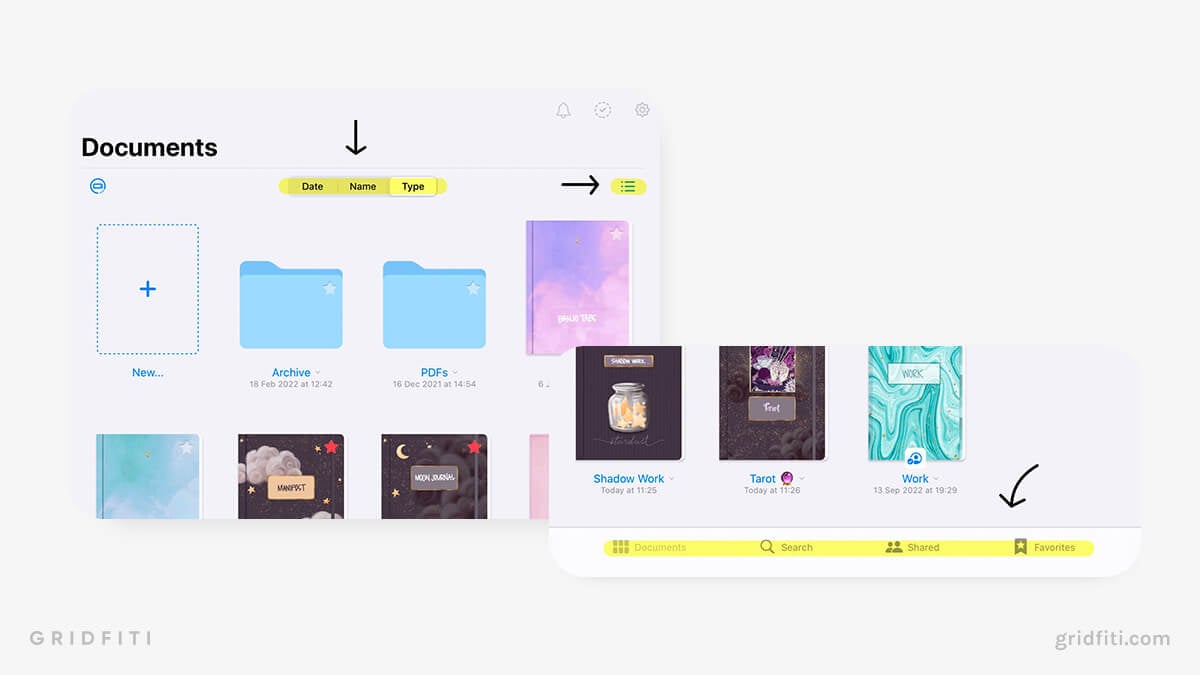
The GoodNotes Document Editor
To access the document editor, all you need to do is open one of your notebooks.
But before we dive in to GoodNotes’ writing features and tools, let’s explore the top navigation menu. This is the dark blue ribbon above the annotation tools and document:

Using the icons on the left-hand side of the navigation bar, listed in order from left to right, you can:
- return to the documents screen
- see the thumbnails of all your document pages, as well as your favorite pages and custom outlines
- search for pages in your document
- bookmark a page
- share or export your document
In the center of the navigation menu, you’ll see the name of your document next to a drop-down arrow. Tap the arrow to see more details about your document, like your last editor and the folder where it’s located.
On the right-hand side of the navigation menu, you’ll see 5 blue icons. Here’s what each of the icons will let you do (listed in order from left to right):
- Undo: Undo an edit.
- Redo: Redo an edit.
- Add page: Scan a document, take a photo, or add a new image or page from a template.
- Editing mode: Tap this icon to switch between editing and view-only mode. Toggling “view-only” mode will hide the annotation tools.
- More settings: Tap this menu to access additional settings, from copying or rotating the page to adjusting your stylus and palm rejection settings.
Just under the navigation menu, you may see a set of tabs:
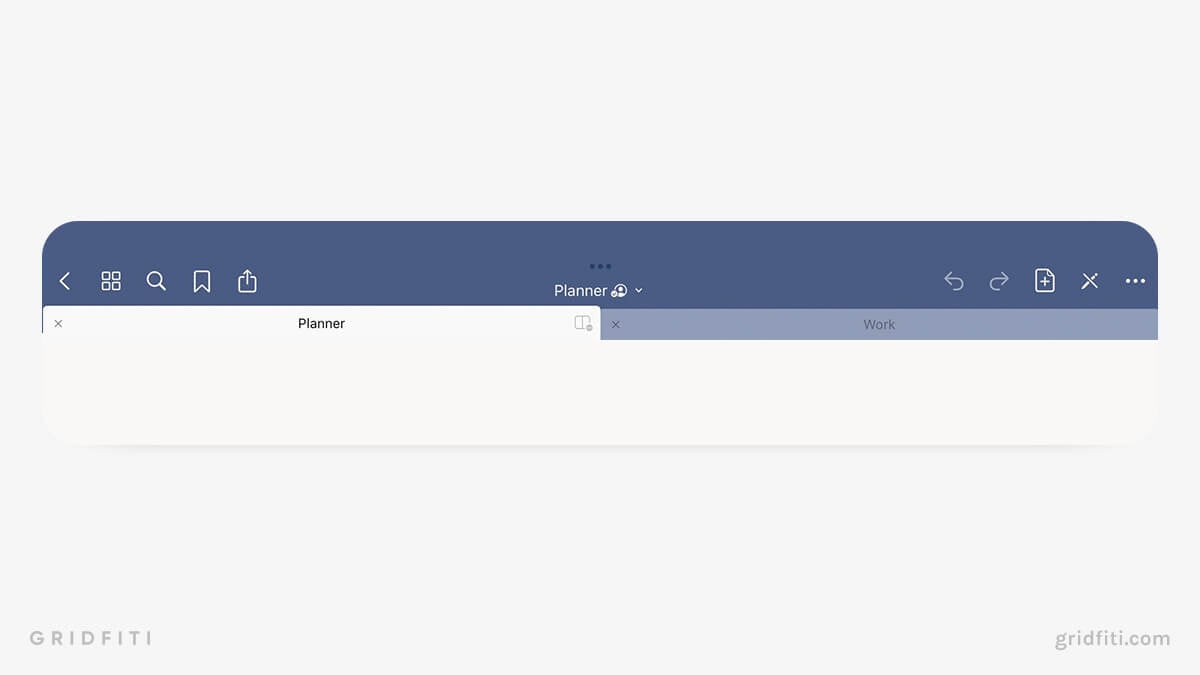 These tabs will appear if you have multiple GoodNotes documents open at once and have toggled on the “Open Documents as New Tabs” option from the Settings in the app’s main home screen. Tap each tab to switch over to that notebook, or tap the X icon to close it. If you close all other notebooks apart from the document that’s currently open, the tabs will disappear.
These tabs will appear if you have multiple GoodNotes documents open at once and have toggled on the “Open Documents as New Tabs” option from the Settings in the app’s main home screen. Tap each tab to switch over to that notebook, or tap the X icon to close it. If you close all other notebooks apart from the document that’s currently open, the tabs will disappear.
Okay, now that’s outta the way, we can get to the fun part: editing your GoodNotes document!
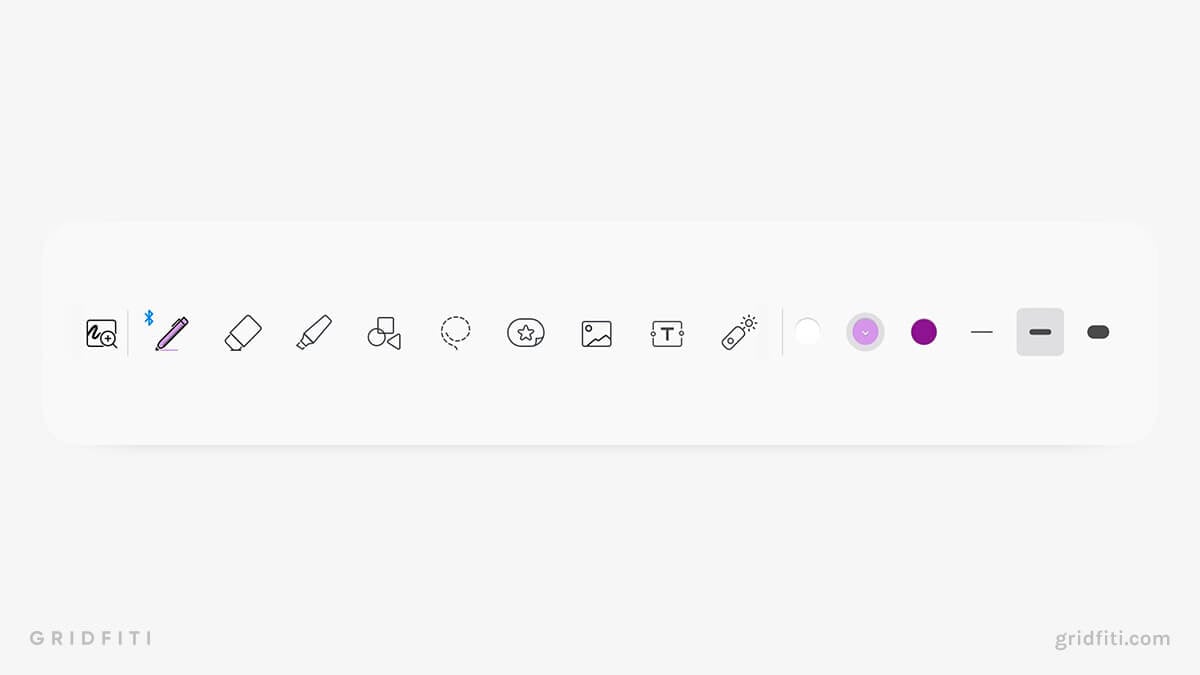 Just below the navigation menu, you’ll see all the tools you can use to annotate your documents (listed in order from left to right):
Just below the navigation menu, you’ll see all the tools you can use to annotate your documents (listed in order from left to right):
- Zoom
- Pen
- Eraser
- Highlighter
- Shapes
- Select (also called lasso)
- Elements (includes stickers)
- Photos
- Text Box
- Laser Pointer
When you tap each option, you’ll see additional options appear on the right-hand side of the toolbar. For example, if you tap the Highlighter tool, 3 colors will appear. Tap a color to change it to a preset option or a custom color of your choosing.
Tap a tool once to use it. Tap the tool again to see more customization options. For example, if you tap the Pen icon twice, you’ll see pressure sensitivity and tip sharpness settings for the brush pen and fountain pen:
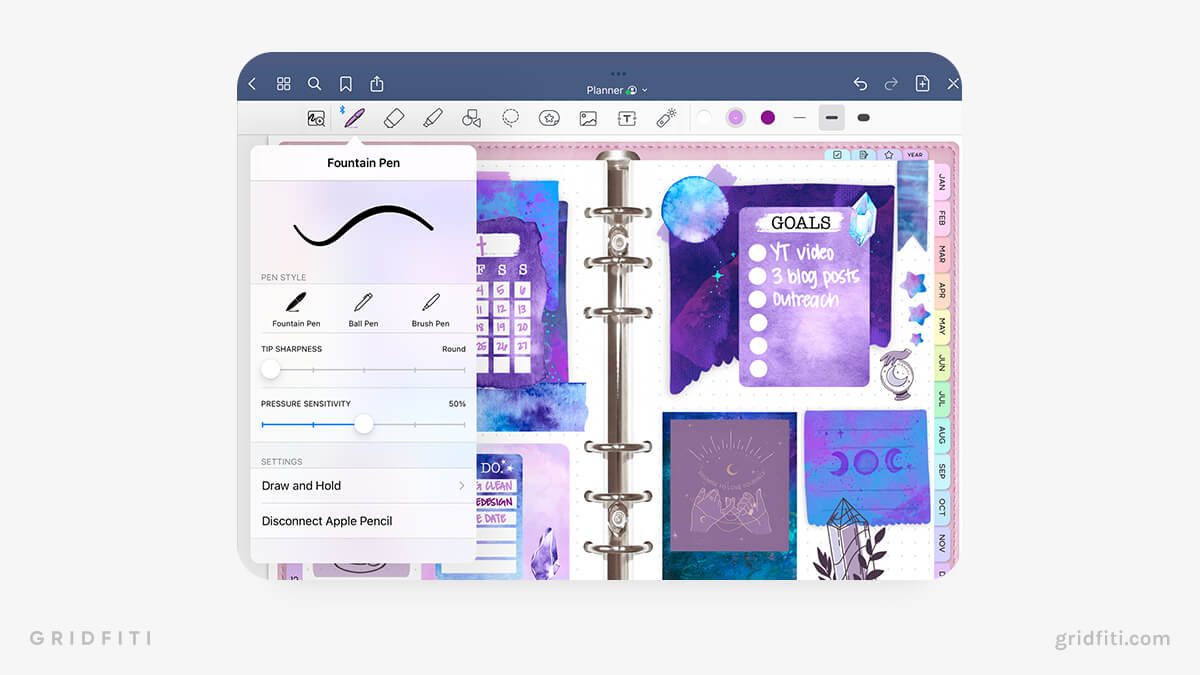 Tapping the Eraser tool twice lets you choose between a Precision, Standard, or Stroke eraser:
Tapping the Eraser tool twice lets you choose between a Precision, Standard, or Stroke eraser:
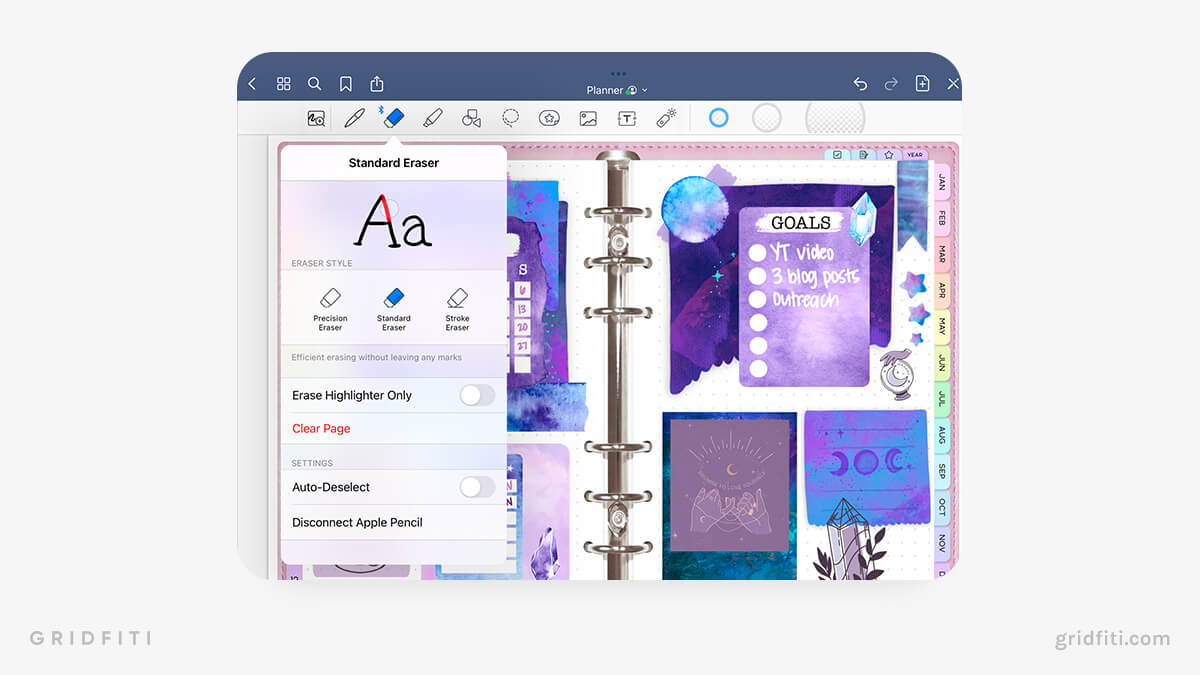 Changes to GoodNotes documents are saved automatically. If you’ve enabled automatic backups of your documents to cloud storage, you can choose to upload those only via WiFi or Bluetooth. Some documents may be excluded from or paused during the backup due to lack of internet access or other app issues.
Changes to GoodNotes documents are saved automatically. If you’ve enabled automatic backups of your documents to cloud storage, you can choose to upload those only via WiFi or Bluetooth. Some documents may be excluded from or paused during the backup due to lack of internet access or other app issues.
GoodNotes Lag Issues
Does GoodNotes lag when uploading or opening large documents? We tested GoodNotes’ lag time with an 883-page document. (Specifically, a digital planner from Happy Downloads.)
It took less than 30 seconds to import this document and about another 15 seconds for GoodNotes to open it. Once it was imported, we didn’t notice any lag when navigating between pages, either by swiping between pages or tapping hyperlinks.
As you’ll notice in the video, there was a slight lag when loading the thumbnail images in Thumbnail view. However, we only noticed this lag when scrolling really quickly through Thumbnail view. We also experienced the slightest lag when opening a page with a lot of text, images, and elements.
Once, after closing and reopening the app, we got this message: “Preparing your library for a faster experience”. It still took less than 30 seconds for the document to load, and we’re not sure what caused the issue, but it’s something to be aware of.
Overall, GoodNotes is a fast app with minimal lag or issues opening and loading documents.
Notability User Interface
When you open the Notability app, you’ll land on the main home screen.
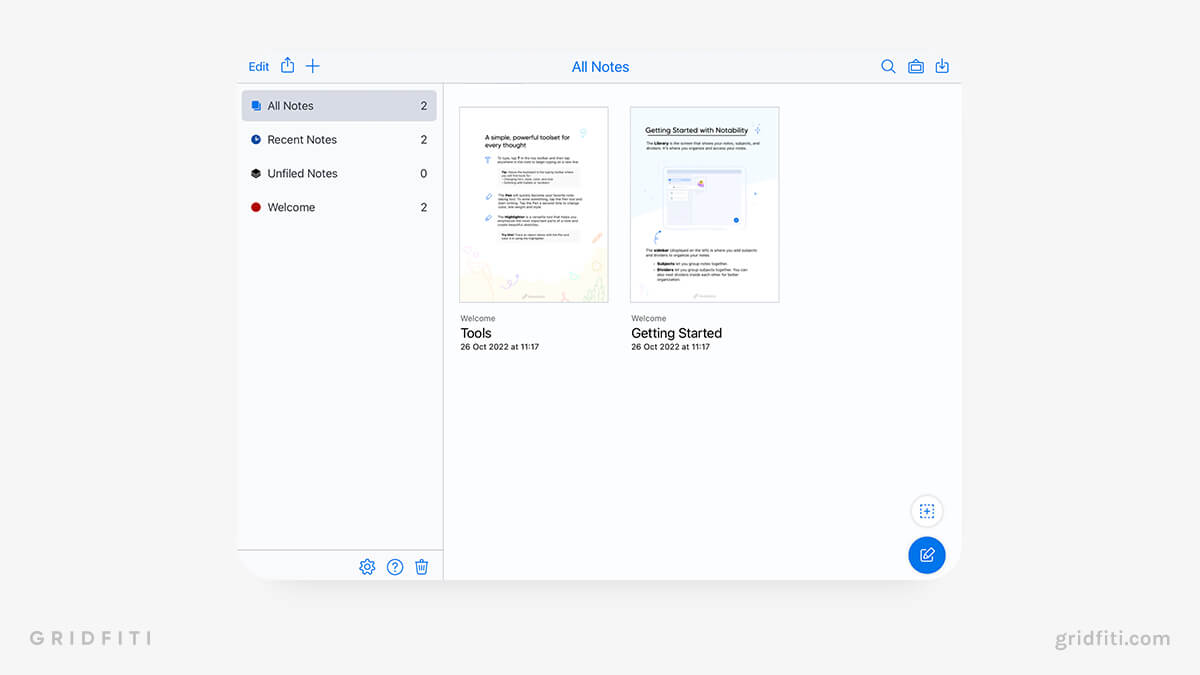 On the right, you’ll see a list or thumbnail view of your notes, while the left-hand sidebar displays your Subjects and Dividers.
On the right, you’ll see a list or thumbnail view of your notes, while the left-hand sidebar displays your Subjects and Dividers.
Notability uses Subjects and Dividers to group notes together. Create a new Subject to group individual notes. Dividers are used to group Subjects. To create a new Subject or Divider, tap the plus sign in the top left-hand corner of the app.
For example, if you have 3 different notes on biology, you could group these into a Subject called “Biology”. You might also have other Subjects for other science subjects, like chemistry or physics. In that case, you could create a Divider titled “Science” that groups related subjects.

To manage your Subjects and Dividers, simply tap and hold the name of the Subject or Divider you’d like to modify. From here, you can edit, rename, or delete it. Tap “Edit” to change the color of the divider or lock it.
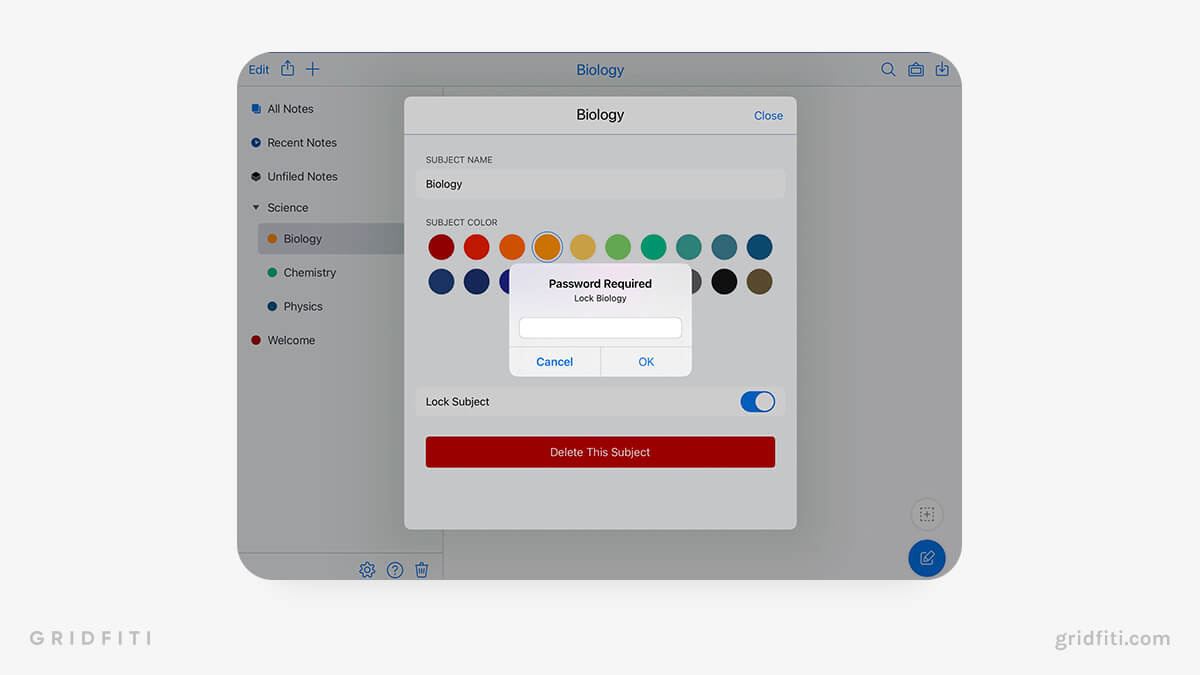 Locking a subject lets you protect it with a password — perfect for protecting sensitive content on a shared device or account. All locked Subjects share the same password. You can also set up Face ID or Touch ID to unlock Subjects as well.
Locking a subject lets you protect it with a password — perfect for protecting sensitive content on a shared device or account. All locked Subjects share the same password. You can also set up Face ID or Touch ID to unlock Subjects as well.
Just above the left-hand sidebar, you’ll see 3 options:

- Edit: Tap this to select notes to edit. From here, you can favorite, delete, or duplicate notes, as well as change the filename.
- Share: Tap this to share notes to the web or Notability gallery. From here, you can also email, print, and share notes in other formats. If you’re using the “Share to” option, you can choose your file type for the export, as well as include or exclude papers and recordings. The “Share to” option also lets you password-protect your exported PDF.
- Add: Tap the plus sign icon to add a new Subject or Divider.
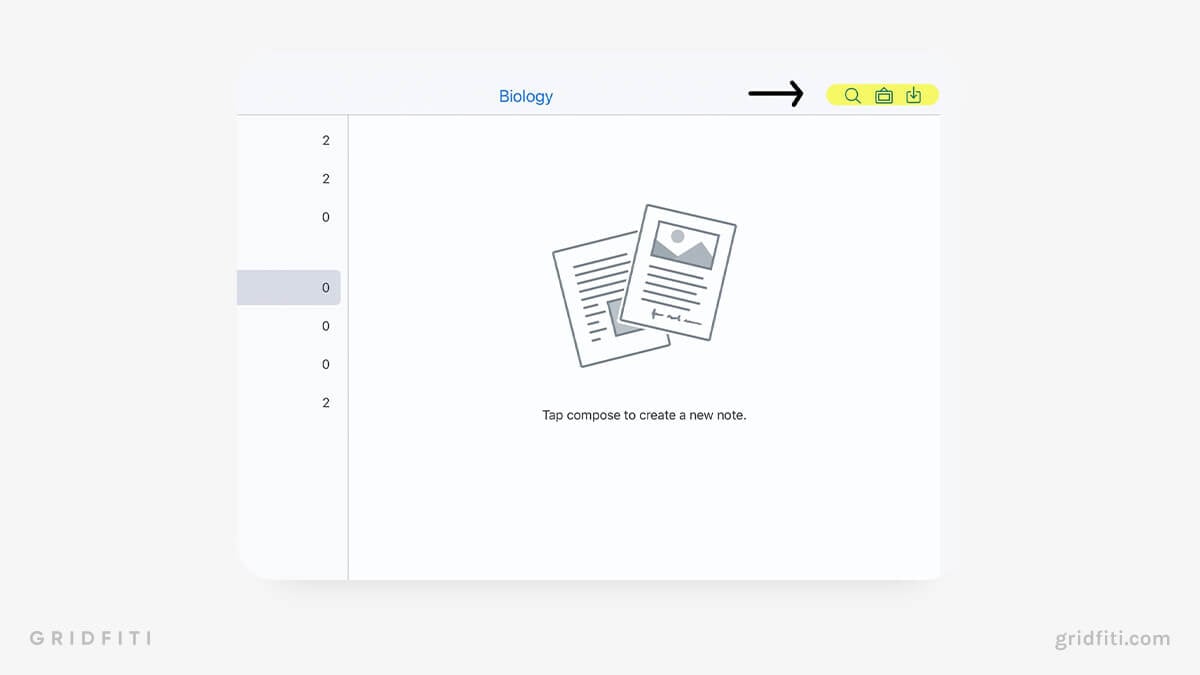 On the right-hand side of the top navigation menu, you’ll find 3 blue icons: Search, Gallery, and Import. (Quick note: It took us a moment to figure out where the Import button was — the icon resembles a “download” option rather than an “upload” option.)
On the right-hand side of the top navigation menu, you’ll find 3 blue icons: Search, Gallery, and Import. (Quick note: It took us a moment to figure out where the Import button was — the icon resembles a “download” option rather than an “upload” option.)
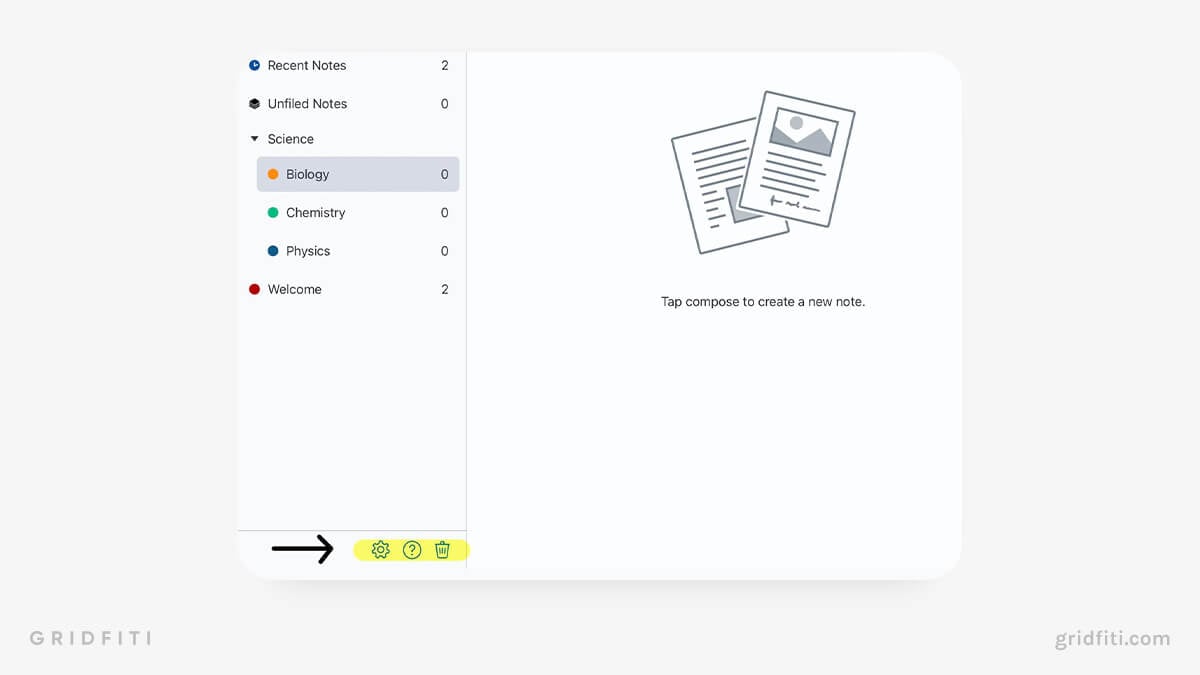 On the bottom right-hand side of the sidebar that shows your Subjects and Dividers, you’ll see 3 icons: Settings, Help, and Trash. From here, you can access your settings, customer support, and your deleted notes.
On the bottom right-hand side of the sidebar that shows your Subjects and Dividers, you’ll see 3 icons: Settings, Help, and Trash. From here, you can access your settings, customer support, and your deleted notes.
On the bottom right-hand side of the area that shows your notes, you’ll see 2 blue buttons:
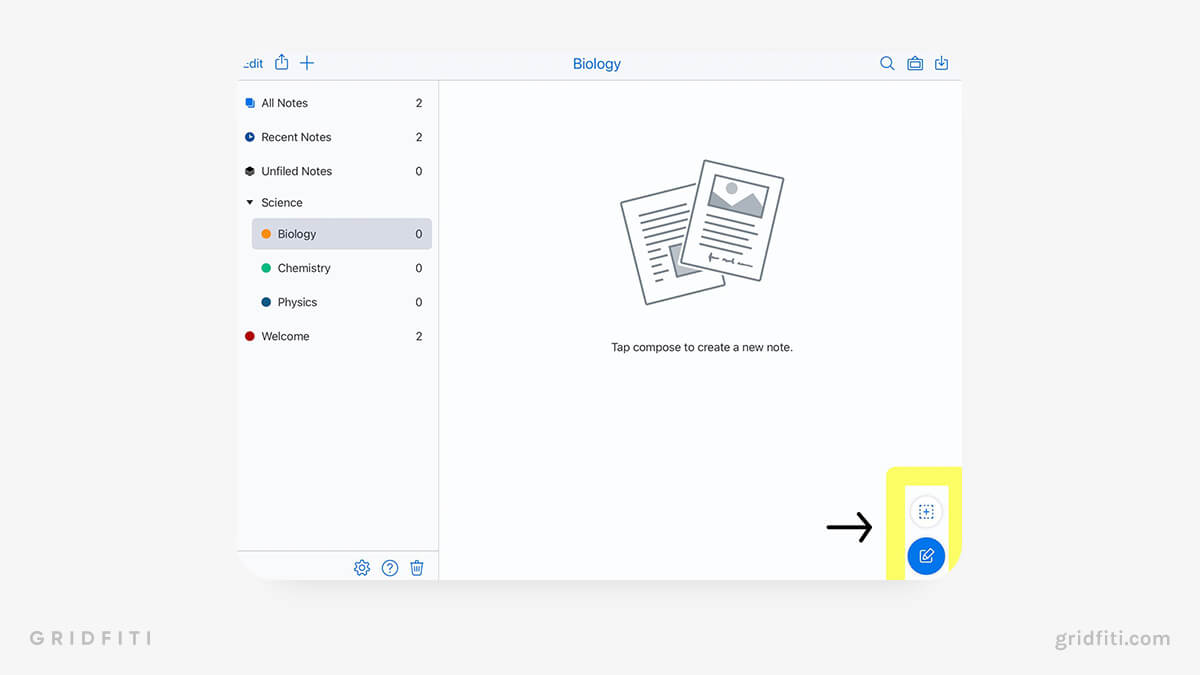 The bottom blue icon lets you create a new blank note. The white icon just above that lets you create a new note from Notability’s template gallery. This is also where you can access templates you’ve previously downloaded from the template gallery.
The bottom blue icon lets you create a new blank note. The white icon just above that lets you create a new note from Notability’s template gallery. This is also where you can access templates you’ve previously downloaded from the template gallery.
Notability’s Notes Editor
Tap a note to open the Notability editor:
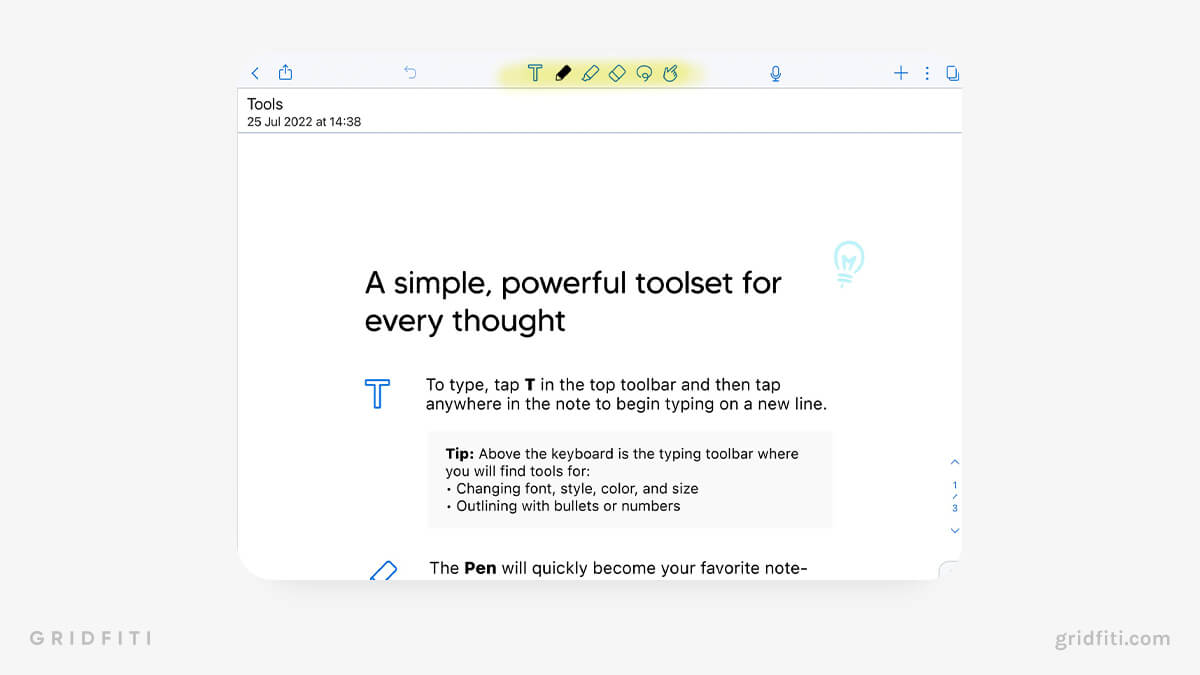 The top navigation menu is more minimalistic compared to GoodNotes’. The left-hand side of the menu lets you return to the home screen or share your document.
The top navigation menu is more minimalistic compared to GoodNotes’. The left-hand side of the menu lets you return to the home screen or share your document.
The middle section of the menu is where you’ll find your writing tools. Listed in order from left to right:
- Undo
- Text
- Pen
- Highlighter
- Eraser
- Select (also called lasso)
- Pan (similar to “view-only” mode in GoodNotes)
- Record
Tap a tool once to use it. Tap it twice to access additional settings.
For example, if you tap the Pen icon twice, you can set the pen thickness, change the color, and choose the line style (solid, brush, or dotted).
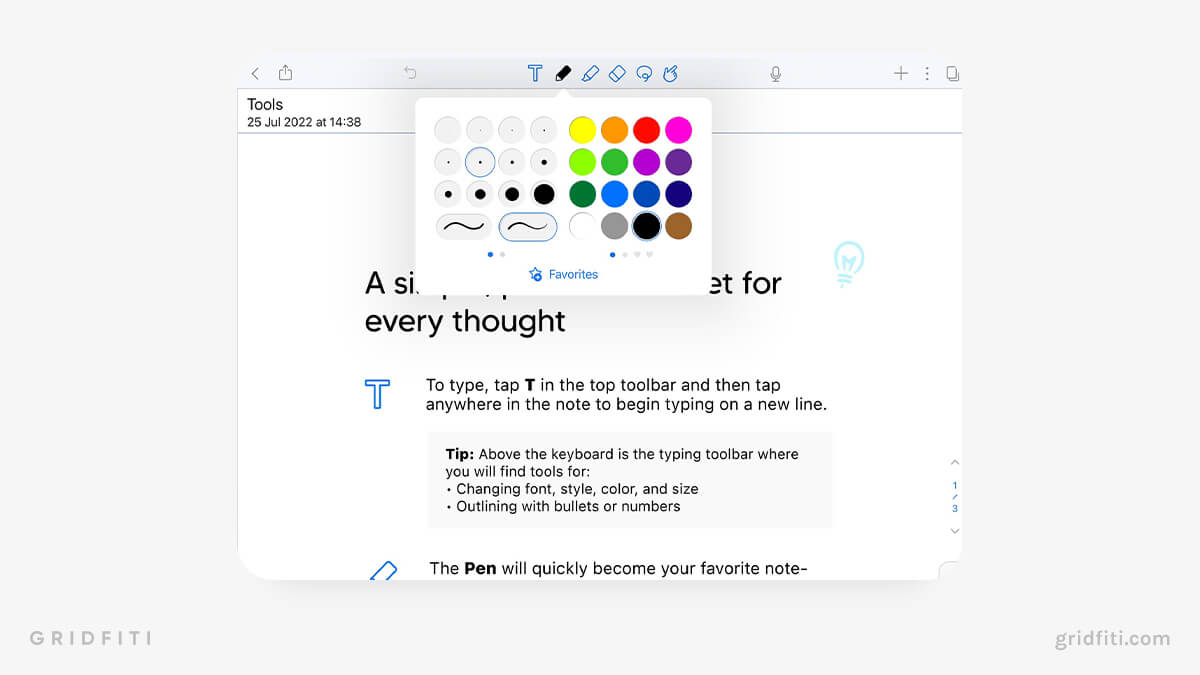 On the right-hand side of the navigation menu, you’ll see 3 icons.
On the right-hand side of the navigation menu, you’ll see 3 icons.
 Here’s what each of the icons will let you do (listed in order from left to right):
Here’s what each of the icons will let you do (listed in order from left to right):
- Plus sign: Scan documents and add media like photos, stickers, GIFs, and sticky notes.
- Options: Access the template gallery, change the page view or show the ruler, see info about your note, and access Notability’s support center.
- Pages: Tap this to see all the pages in your note. From here, you can search for a page, select a page to be copied, pasted, or duplicated, and bookmark a page. Tap one of the blue page icons at the top of the sidebar to switch between viewing all pages, bookmarked pages, and pages with handwriting.
Notability Lag Issues
We tested Notability’s lag time with the same 883-page planner we used for GoodNotes.
Notability imported the planner quicker than GoodNotes — the import took less than 10 seconds. There was a very slight delay between importing and opening the document We experienced a slight lag after closing and reopening the document again. We also experienced some lag when scrolling very quickly through the pages in the main editor (but not in the sidebar).
Writing with an Apple Pencil caused the most lag issues for our test. We found the Notability app was about half a stroke behind when writing quickly. The lag was worse when we wrote a letter and lifted the pencil off the screen before writing the next letter. We noticed the lag wasn’t quite so bad when we did not lift the pencil between each letters.
Overall, Notability imports notes quickly but does have some slight lag issues when writing and scrolling quickly. However, these may not be noticeable to the average user.
Note-Taking Comparison
Both GoodNotes and Notability are great solutions for note-taking. The app that works better for you depends on your preferences. Here’s a quick guide to help you determine which app is right for you.
Notability might be a better option for note-taking if:
- you like to have a running view of your notes instead of dividing them up into individual pages.
- you often add screenshots of webpages to your notes.
- you need a note-taking app that can convert handwritten equations to text.
GoodNotes might be a better option for note-taking if:
- you like to split up your notes into individual pages.
- you want more pen style options.
- you want to configure your handwriting position and pressure sensitivity.
Notability vs. GoodNotes for Students
Which note-taking app is better for students: Notability or GoodNotes? That all depends on your unique needs and budget, but our winner is GoodNotes. (We’ll discuss why in just a moment.)
Some of Notability’s features — like web clips, in-app audio recording, and the math converter — are especially helpful for students who use Notability to study. STEM majors in particular might find Notability suits their needs better than GoodNotes.
However, Notability’s subscription model may not be ideal for broke college students living on ramen and a prayer. So if you’re concerned about price, GoodNotes offers all the note-taking features you need as a student for a one-time fee.
Both GoodNotes and Notability offer free plans for institutions that use Apple School Manager, so if you’re eligible for a free account, try them both out and see which one you prefer!
To start using GoodNotes for your academic life, check out our round-up of pre-made GoodNotes templates for students.
How to create Flashcards in GoodNotes
Unlike Notability, GoodNotes offers an experimental feature that’s super useful for students: Flashcards. This is precisely why we think GoodNotes is a better option for students.
Here’s how to create Flashcards in GoodNotes:
- Open a GoodNotes document.
- Tap the blue “Add page” icon in the top right-hand corner of the navigation bar.
- Tap “More from Templates”.
- Under “Essentials”, scroll to the right until you see “Flashcard”.
- Tap the Flashcard template you’d like to use, then tap “Apply”.
- Edit your Flashcard using the annotation tools.
To study your flashcards, tap the blue menu icon in the right-hand corner of the navigation menu, then scroll down to “Study Flashcards”. GoodNotes uses the spaced repetition technique to help you retain what you’ve learned.

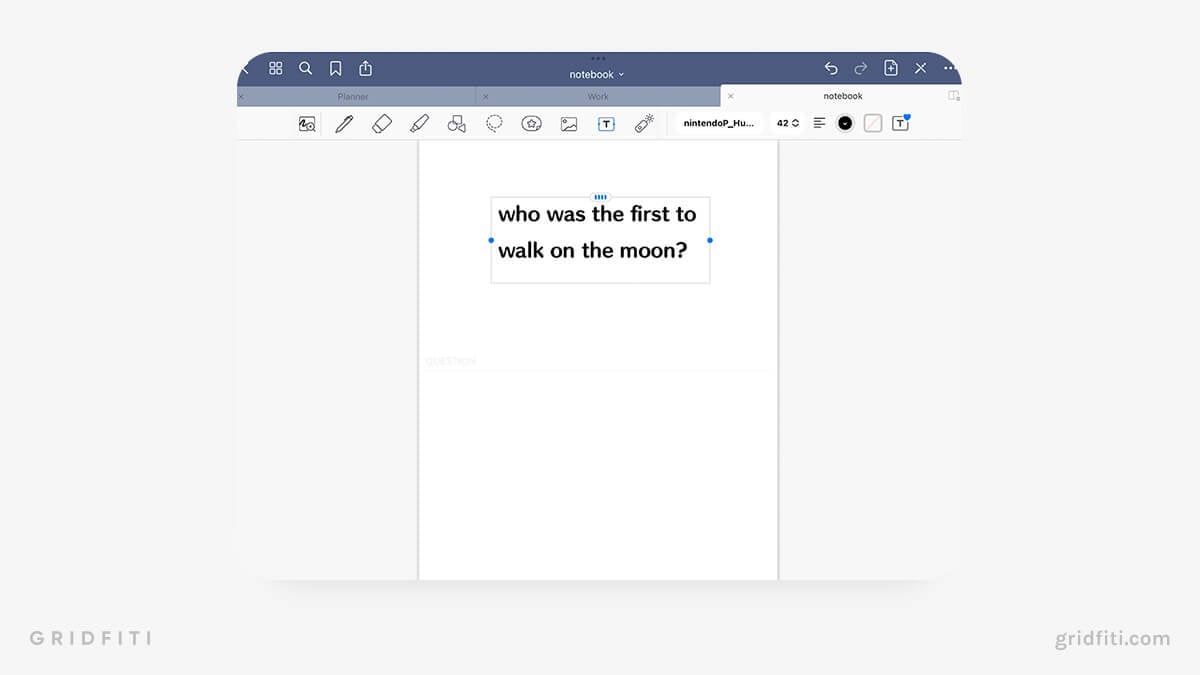

Notability vs. GoodNotes for Digital Planning
Is Notability or GoodNotes better for digital planning? Again, it all depends on your preferences, but Notability gets some extra brownie points for its planner-friendly features.
Notability offers a gallery with pre-made planners, notebooks, stickers, and templates created by designers and other Notability users. While GoodNotes offers some page templates and notebook covers, it doesn’t offer done-for-you planner templates like Notability does. Notability’s ruler feature also makes it easier for digital planners to create even layouts.
GoodNotes does offer 2 very basic monthly planning template pages, but that’s about it.
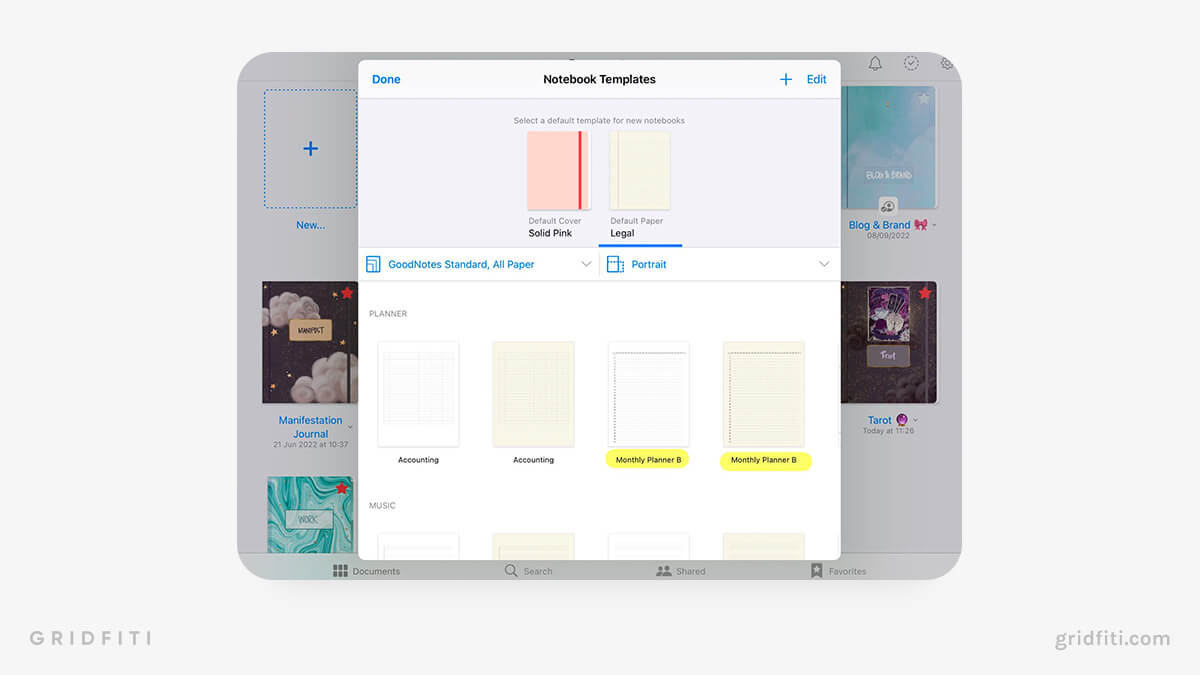 If you want to use GoodNotes for digital planning, you have 2 options: create your own planner from GoodNotes’ page templates and notebook covers, or download a planner from the web.
If you want to use GoodNotes for digital planning, you have 2 options: create your own planner from GoodNotes’ page templates and notebook covers, or download a planner from the web.
You’ll find many free and paid GoodNotes planners on sites like Reddit and Etsy. If you’re savvy with apps like Canva and Keynote, you can also design your own aesthetic GoodNotes planner, complete with hyperlinked pages and custom page templates.
Notability might be a better fit for digital planning if you:
- don’t want to purchase stickers or planners from a third party (like Etsy).
- like a seamless view of your planner.
- often add voice recordings or webpage screenshots to your planner.
GoodNotes might be a better fit for digital planning if you:
- would prefer to create, purchase, or download your own planners, stickers, and templates from another source.
- want more control over your writing experience.
Get a head start with your GoodNotes planning with these robust GoodNotes planner templates!
Closing Thoughts: Is GoodNotes or Notability Better?
Our verdict: GoodNotes!
GoodNotes gets the Gridfiti seal of approval over Notability for several reasons. Not only is it more affordable, but it also offers a smoother, more intuitive writing experience.
Sure, Notability has some features that GoodNotes doesn’t, like rulers, in-app audio recording, and equations. And the app does integrate with more cloud services for backups, and also offers more file formats for export. But we’re not sure those extra bells and whistles are worth the subscription fee, especially considering the issues we had with the Apple Pencil compatibility during testing. However, we will admit the additional planners and templates in the community gallery are a nice touch.
Don’t get us wrong — Notability is still a great choice for anyone looking for a note-taking app. If you value privacy and are using a note-taking app on a shared device, Notability is the way to go since it lets you password-protect your exports and subjects.
Really, it all comes down to your needs, budget, and preferences. So tell us — which note-taking app do you prefer: GoodNotes or Notability?
Gridfiti is supported by its audience – when you buy something using the retail links in our posts, we may earn a small commission at no additional cost to you. Read more about our affiliate disclaimer.